

Max Davies
2026 Toyota HiAce review
1 Hour Ago
The Mercedes-AMG A45 S rewrote the rules for what's possible from a hot hatch. Now, the Audi RS3 is after its crown.

Contributor


Contributor
Hot hatches are all grown up.
Forget about simple, front-wheel drive powertrains and affordable sticker prices, the likes of Mercedes-AMG and Audi have evolved the formula to a point where you can enjoy supercar performance in a body nicked from the average city hatchback.
The first-generation AMG A45 was no shrinking violet, but Mercedes-AMG turned up the wick further for the sequel.
With record-breaking outputs from its 2.0-litre turbocharged engine, a sophisticated all-wheel drive system with Drift Mode, and a higher-tech interior, it took the hyper hatch class to new places.
An update is due in 2023, but it won’t bring any changes to the critical hardware under the skin. Instead, changes are limited to a revised version of its MBUX interior software and some minor styling changes.
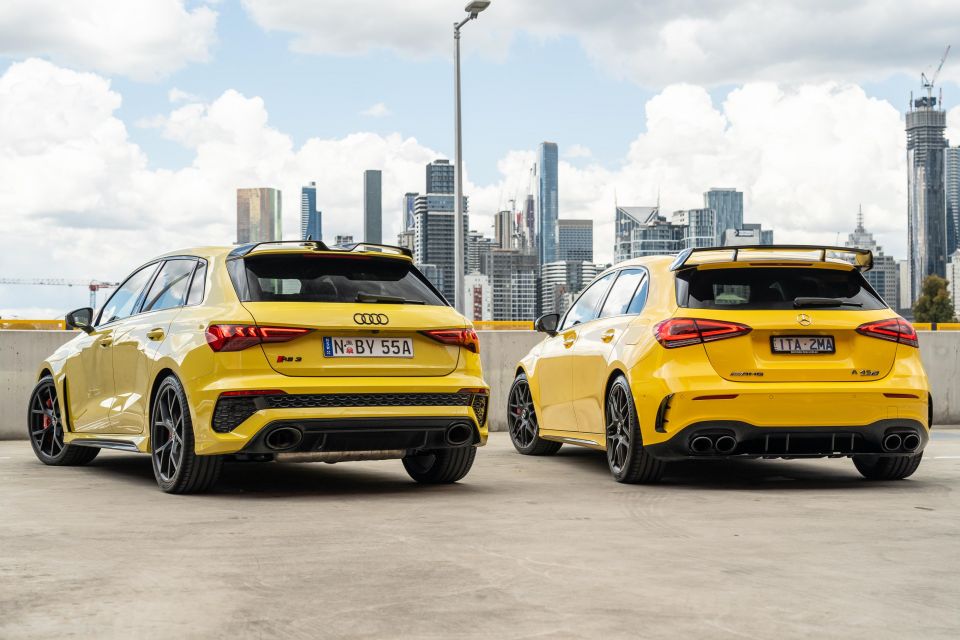
Someone in Ingolstadt was clearly taking notice of how far Affalterbach has pushed its smallest car, because the new Audi RS3 is an altogether more serious beast than its predecessor.
It’s still powered by a characterful five-cylinder engine, and it’s still all-wheel drive, but Audi has widened the front track, and has subbed the old Haldex quattro system for a more sophisticated ‘torque splitter’ setup with drift mode.
Is the Mercedes-AMG A45 S still the hyper hatch king, or has the new Audi RS3 stolen its crown?
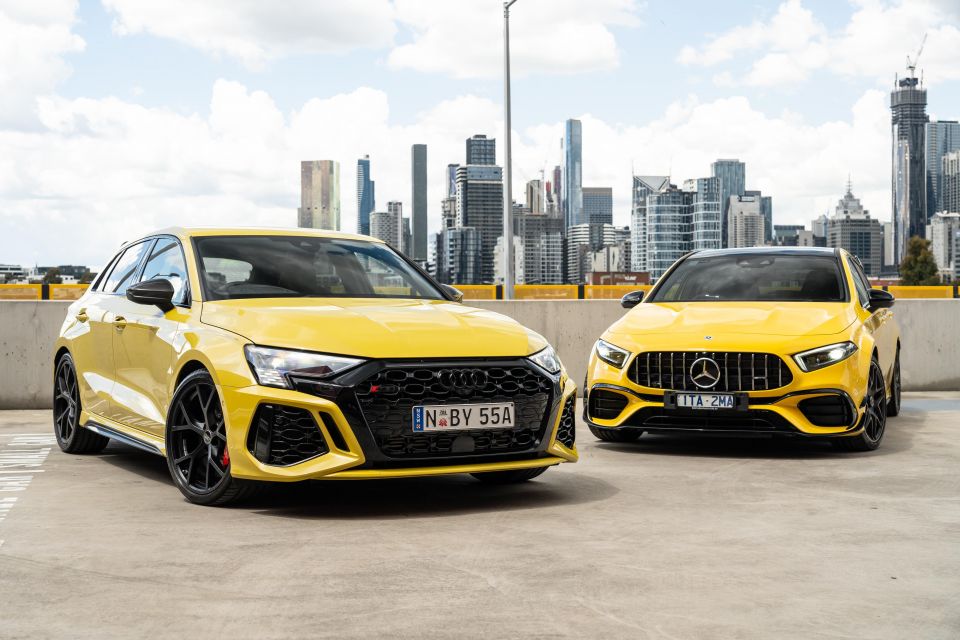
The Mercedes-AMG A45 S has pushed the boundaries of how a hot hatch can perform, but it also pushes how much people will pay.
Pricing for the A45 S hatchback kicks off at $99,895 before on-road costs, and the AMG Performance Package fitted to our tester ups that to $105,685 before on-road costs.
Sun Yellow paint is a solid colour, and is therefore a no-cost option.
The Audi RS3 starts at $91,400 before on-roads in Sportback guise, undercutting its rival by $7495. The options fitted to our tester, however, made it the more expensive of the two cars on test.
The Carbon Package ($7400) and RS dynamic package plus ($13,000) made our Python Yellow Metallic tester a $111,800 proposition before on-roads.
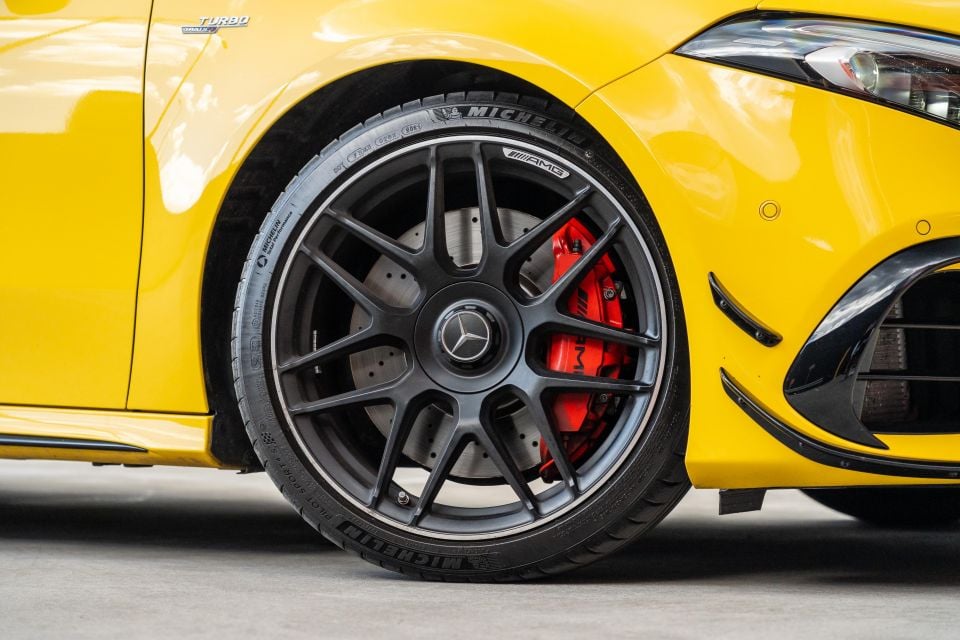
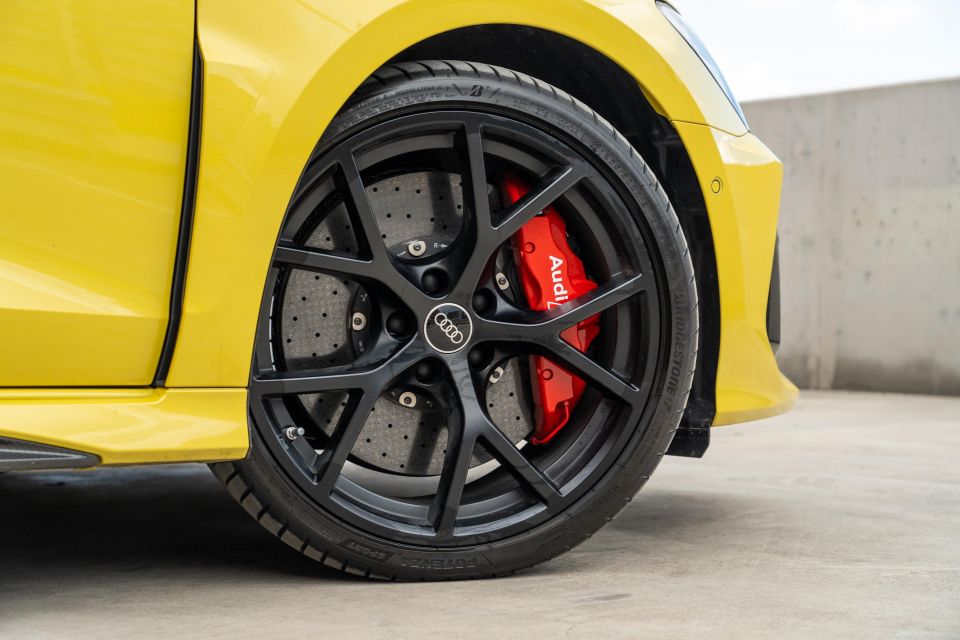
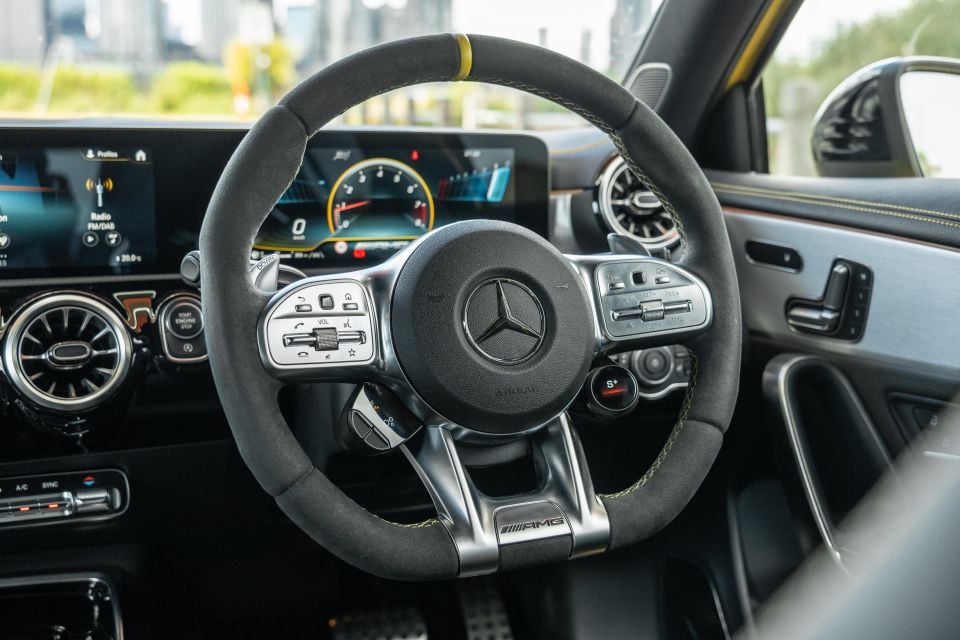
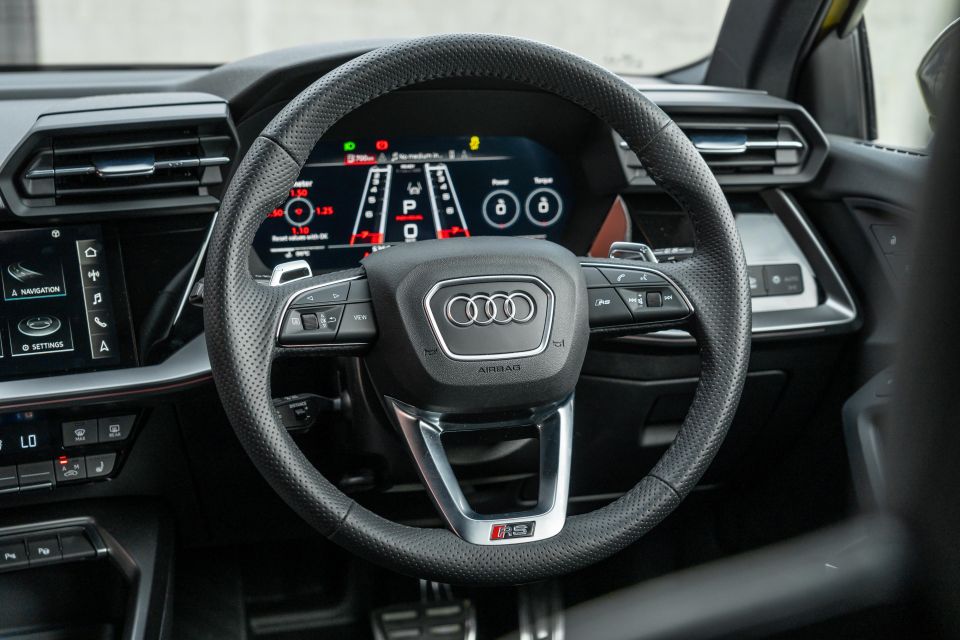
Equipment common to both cars includes:
Equipment unique to the Mercedes-AMG A45 S includes:
Equipment unique to the Audi RS3 includes:
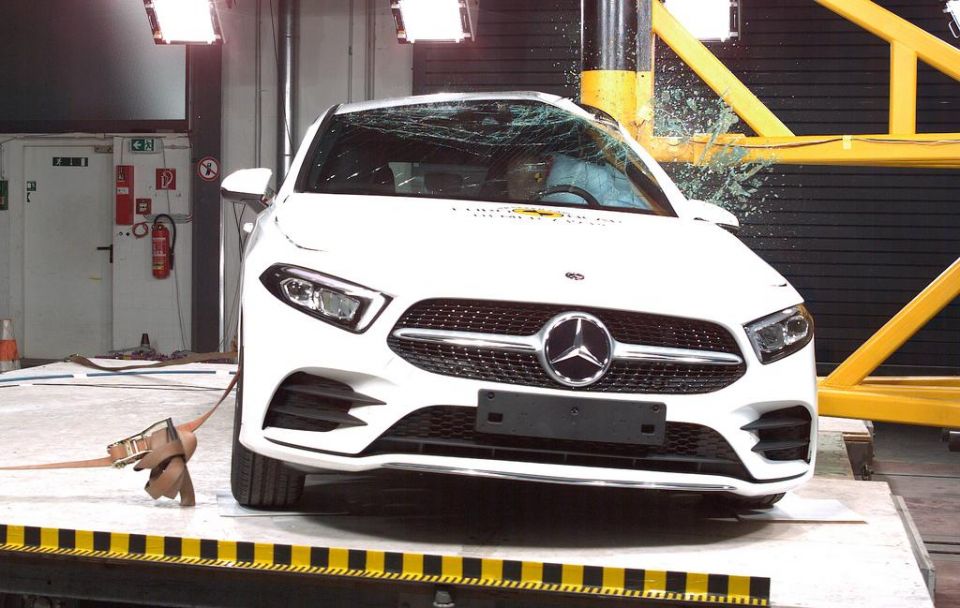
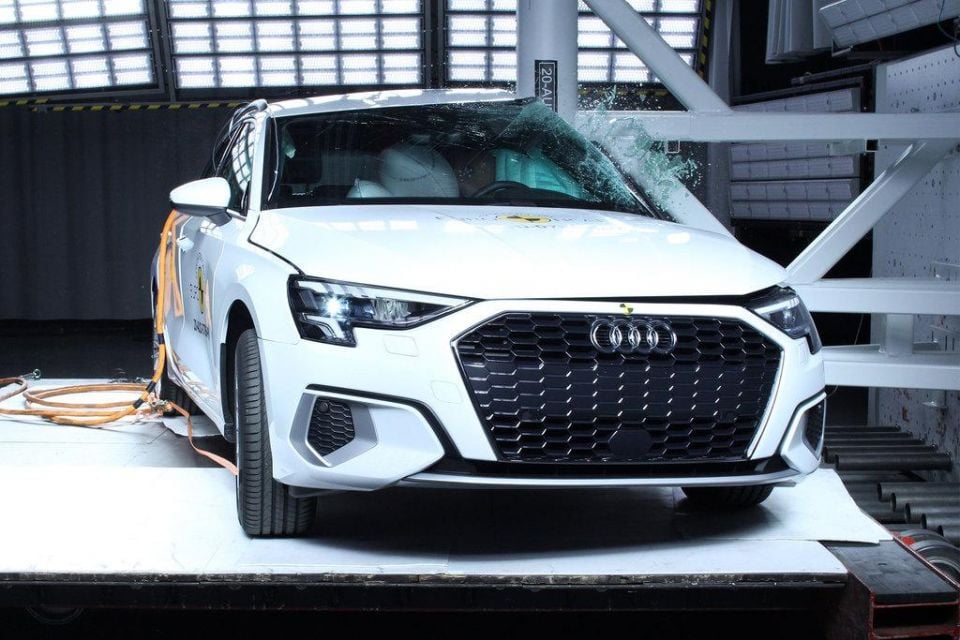
Mercedes-AMG A45 S
The Merceds-AMG A45 has a five-star ANCAP safety rating based on testing carried out on the non-AMG A-Class.
It scored a 96 per cent adult occupant safety rating, a 91 per cent child occupant safety rating, a 92 per cent vulnerable road user protection score, and a 73 per cent safety assist score.
Audi RS3
The Audi RS3 is unrated by ANCAP and Euro NCAP, though front-wheel drive A3 models wear a five-star rating.
Category scores included 89 per cent for adult occupant protection, 81 per cent for child occupant protection score, 68 per cent for vulnerable road user protection, and 73 per cent for safety assist.
Standard safety equipment on both models includes:
The RS3 adds rear cross-traffic assist, which will actively brake the car if it detects passing traffic rather than simply alerting the driver, to that list.
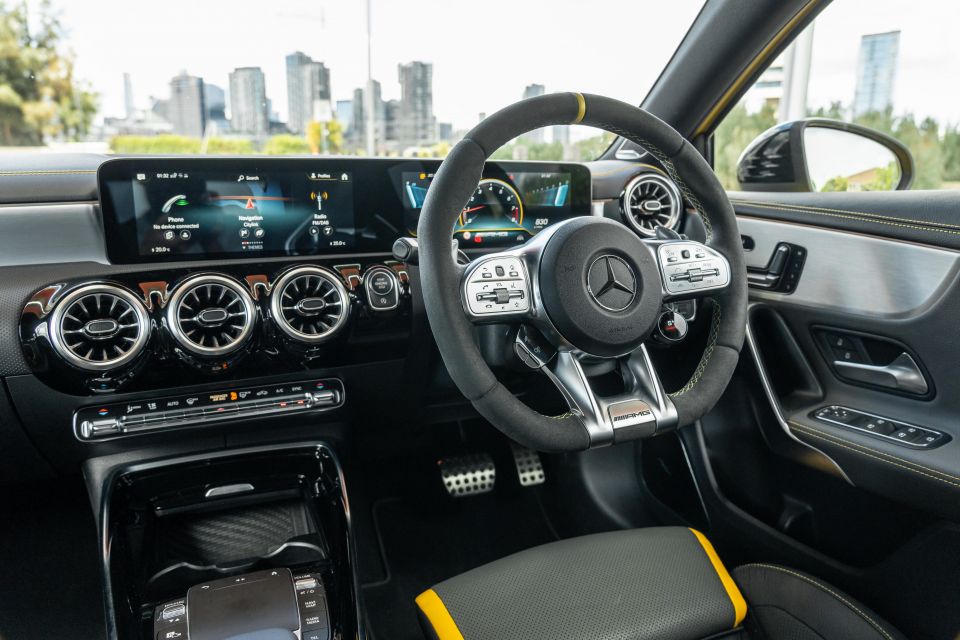
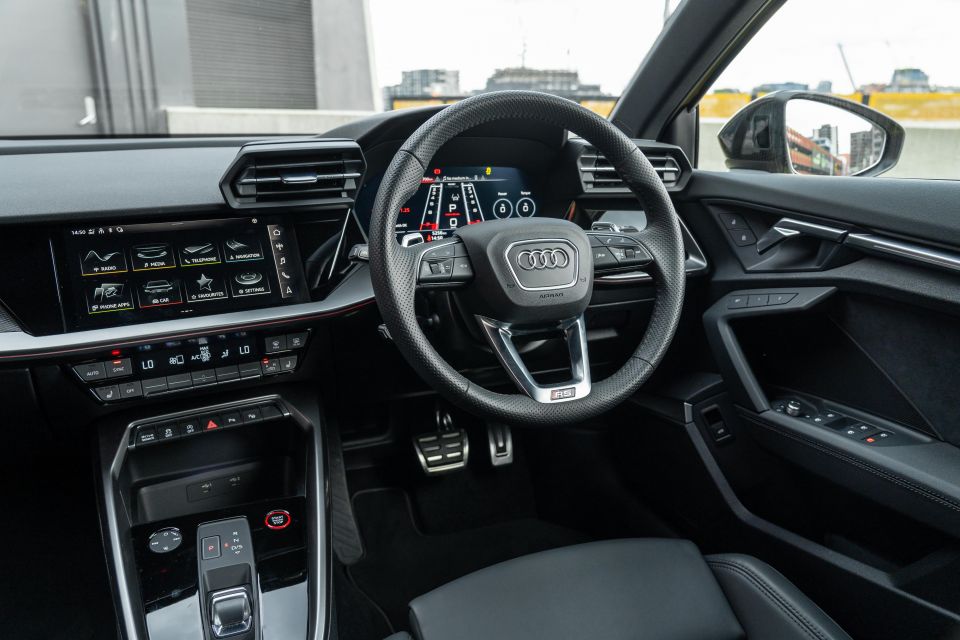
Mercedes-AMG A45 S
A chunk of the A45 S is familiar from the wider A-Class range, but the bits that matter feel properly special.
The flat-bottom steering wheel, complete with Alcantara trim, has been lifted from a C63 with its mode buttons and dials, and the optional sports seats hug you tightly. I love that Mercedes-AMG puts all the key functions in easy reach; rather than having to dive through menus it makes skipping through drive modes a breeze.
Their firm bolsters might not play nice if you’re wider than you are tall, but race drivers aren’t given a free pass to eat burgers and drink beers, so why should you be?
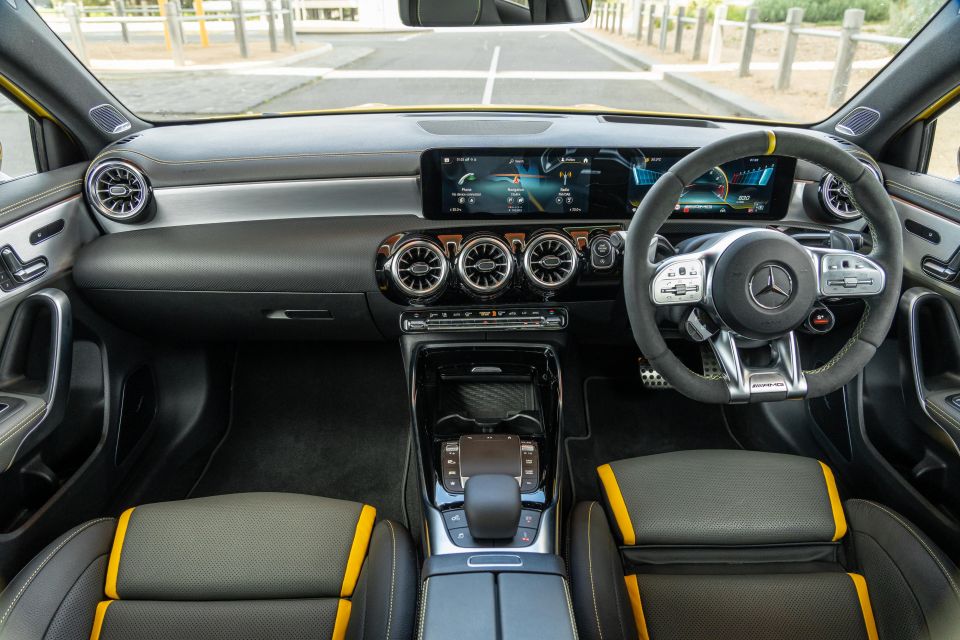
Years on from launch, the A-Class interior remains a showstopper. The trio of round vents looks expensive, and the ambient lighting is straight off the motor show floor. The vents even flash red when you turn the temperature up, or blue when you turn it down.
Not all the flashy materials feel high-end, though. The plastic toggle switches in the climate control pod feel cheaper than the cabin’s rockstar design might suggest, and things like the door grabs are a little flimsy relative to what you’d expect of a Mercedes-Benz.
MBUX is a good infotainment system, but refinements are needed. Wireless CarPlay and Android Auto are coming in 2023, which will be a step, as will the ability to view those apps in widescreen rather than a narrow window.
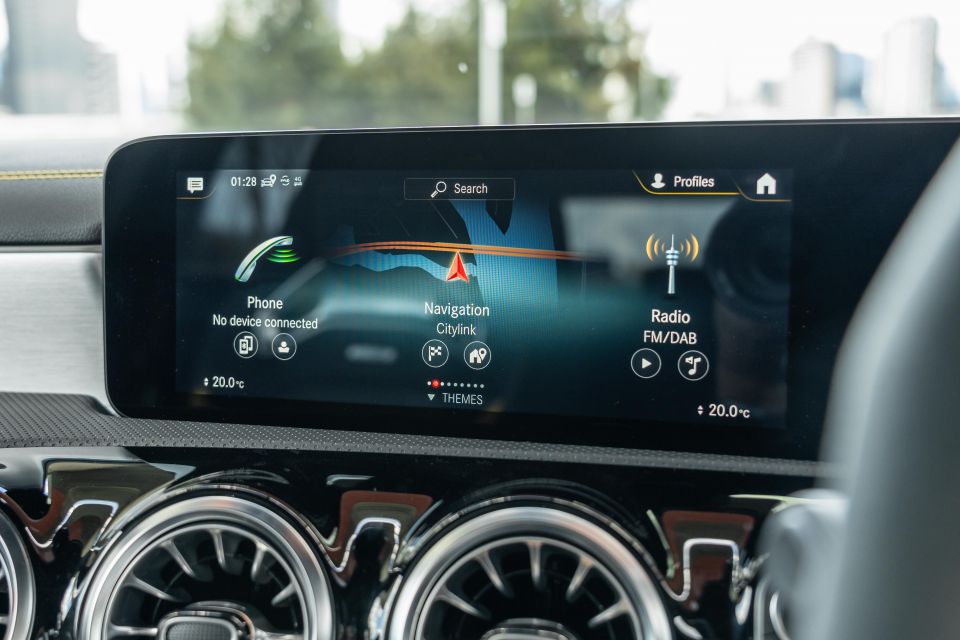

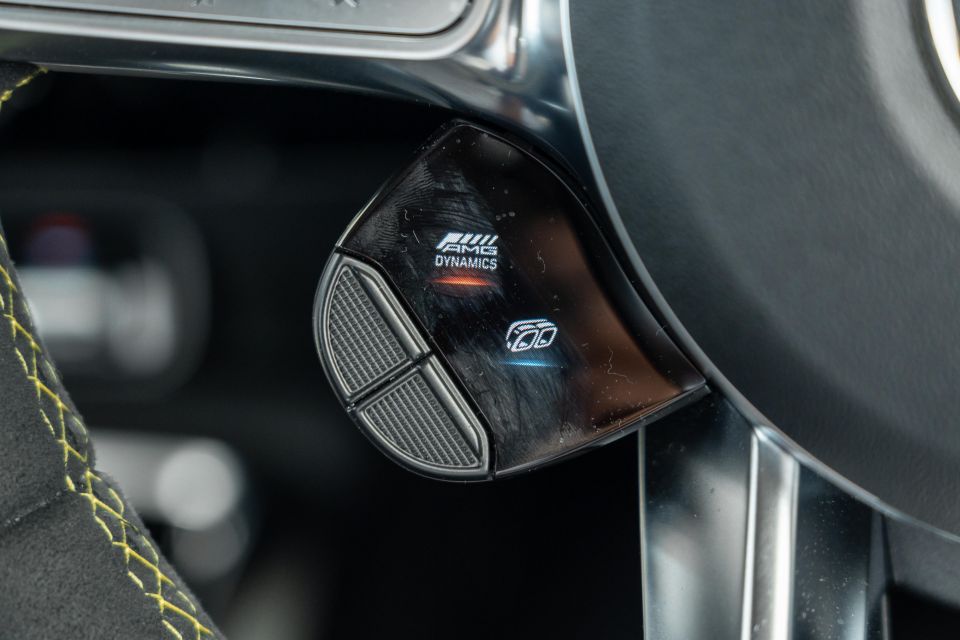
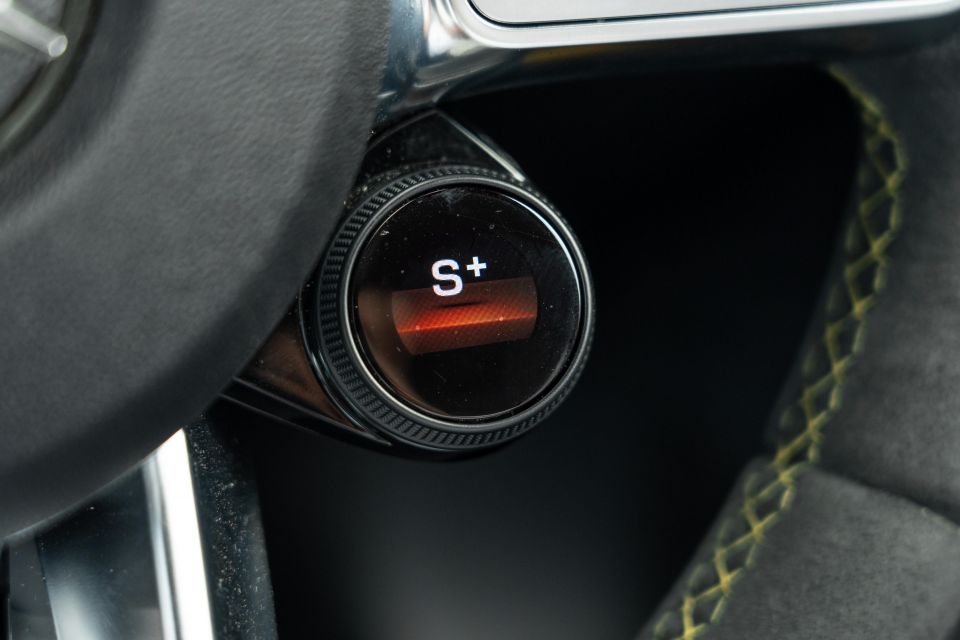
The pad, touchscreen, and voice controls all work well, but the way it’s all laid out carries a steeper learning curve than the system in the RS3. Both screens are pin sharp, and respond quickly to inputs.
Where it blows the RS3 away is when it comes to performance displays. Not only can you time a 100km/h sprint or map your lap times in the AMG, the way all the data is laid out wouldn’t look out of place in Gran Turismo.
Storage space up front is slightly better than in the Audi. There’s a sliding cover over the cupholders and wireless charger, and the glovebox has more space than the low-profile unit in its rival.
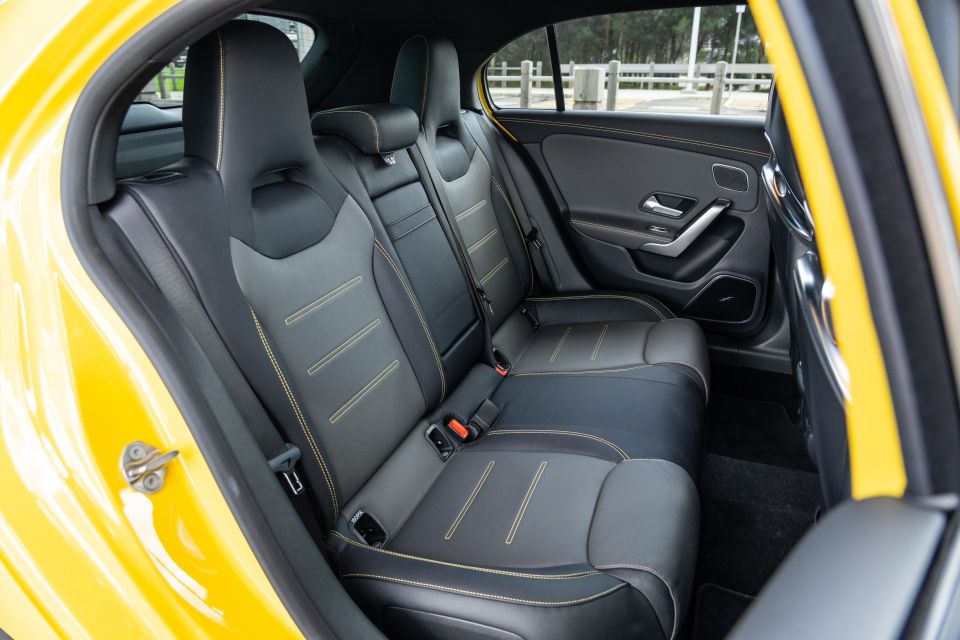
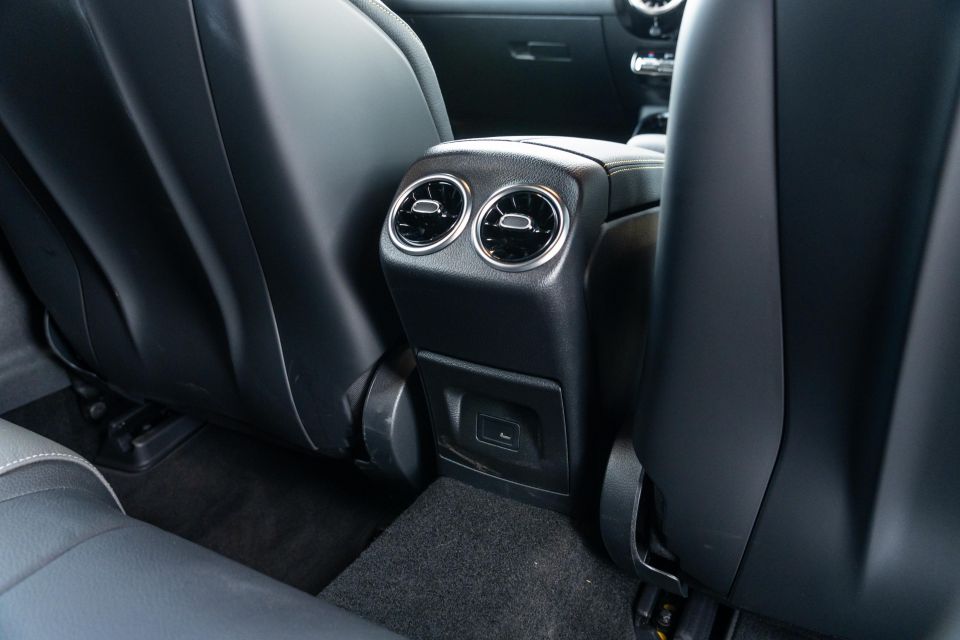

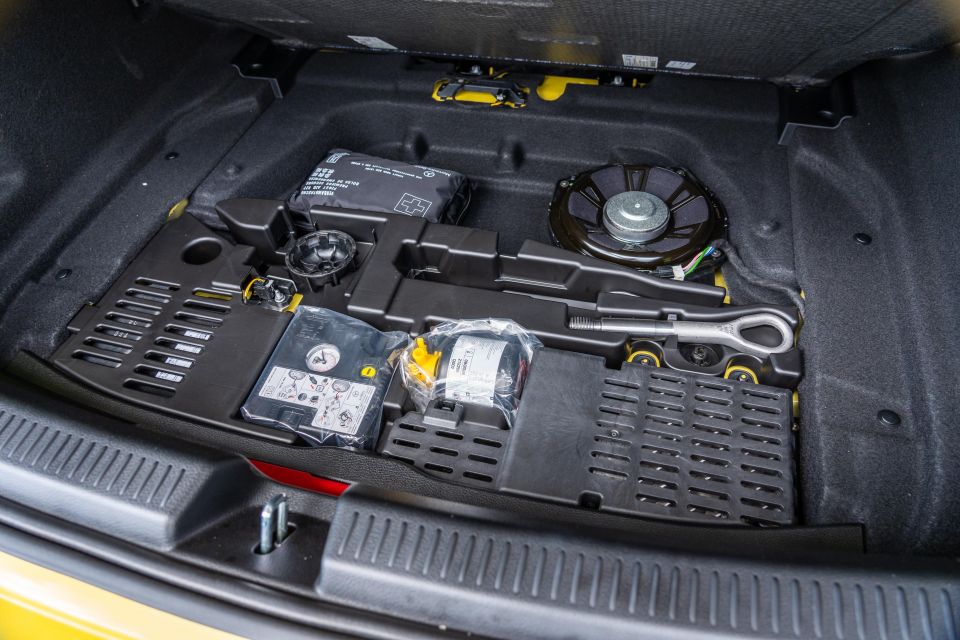
The rear seats have been a weak point for the current A-Class since launch, and that remains the case here. Headroom is acceptable but not standout, and legroom behind the hard-backed front seats is tight for anyone but small kids. The air vents, dual USB-C ports, and fold-down central armrest are welcome inclusions.
Boot space is much better in the A45 than the RS3, however. On paper it has close to 100L more room, and in practice that means you’ll get a set of golf clubs in there (with the driver removed) where you need to fold the seats in the Audi.
It’s a deeper, wider space that’ll prove more useful on weekends away or school runs. Both these cars feature 40:20:40 folding seats.
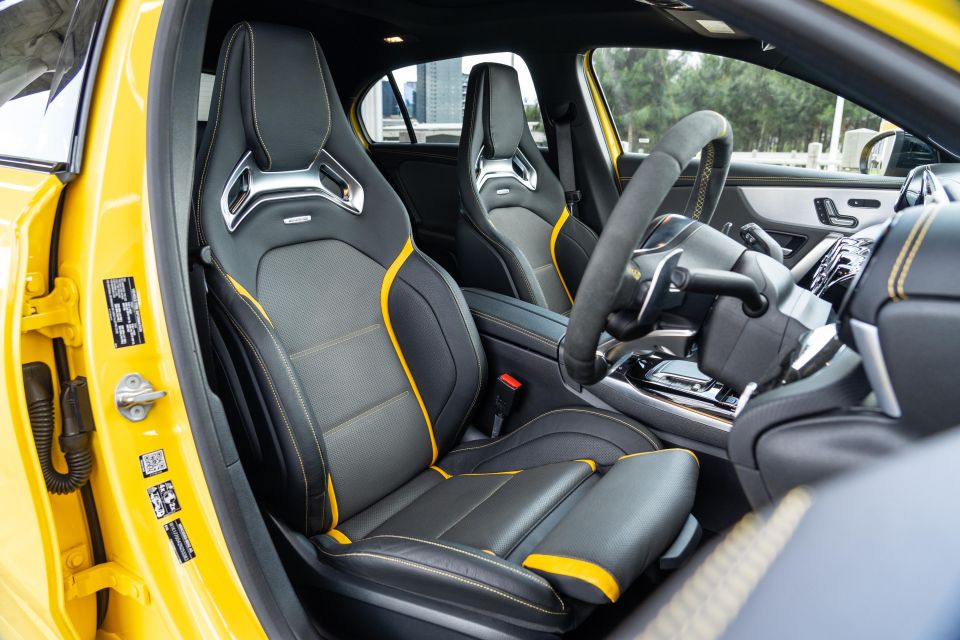
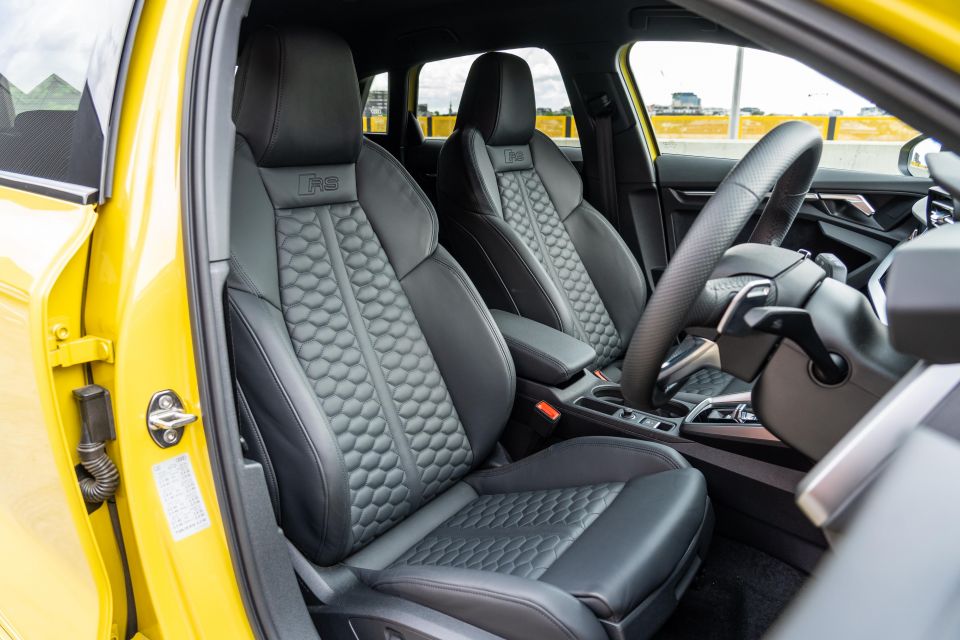
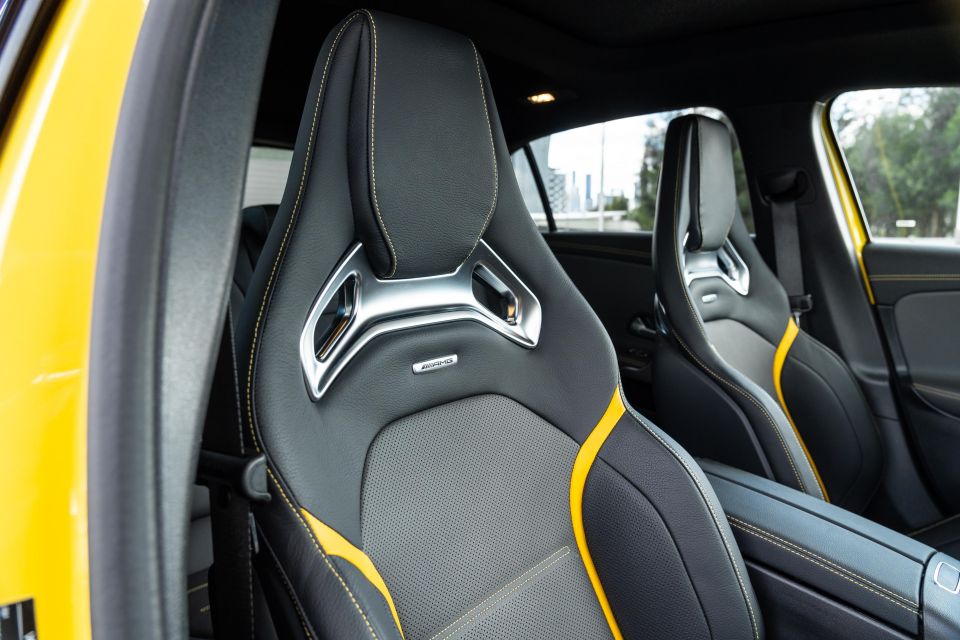

Audi RS3
The Audi lacks the show car sizzle of the A45, but it’s a more comfortable and intuitively laid-out cabin.
Although they don’t look purposeful and racy like the buckets in the Mercedes-AMG, the quilted leather seats in the RS3 are much more comfortable for the daily grind. They’re not short on bolstering, although they don’t hold you as tight when you’re really pushing hard.
The leather steering wheel doesn’t look or feel as special as the Alcantara unit in the AMG; the metal-backed paddles are smaller, you don’t get the same range of options for drive mode customisation, and there’s no 12 o’clock marker.
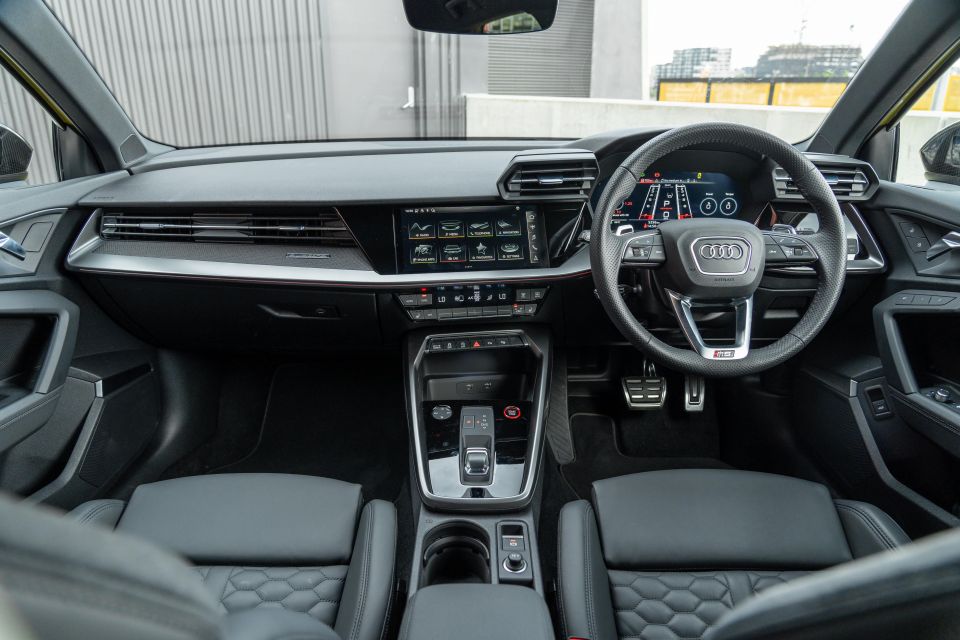
You do get a shortcut button on the wheel that can jump directly to a preset RS mode, however, and the driving position is excellent. This is the more comfortable car for long stints behind the wheel.
What it lacks in flashy ambient lighting, the RS3 makes up for with usability. The infotainment system is within easy reach and tilts nicely towards the driver, and it’s every bit as fast as MBUX. It’s also easier to navigate, with colourful buttons and a permanent shortcut bar down the right-hand side of the screen.
Apple CarPlay is wireless and worked flawlessly, and the haptic feedback that clicks when you prod an icon makes it easy to know if you’ve actually done what you set out to.
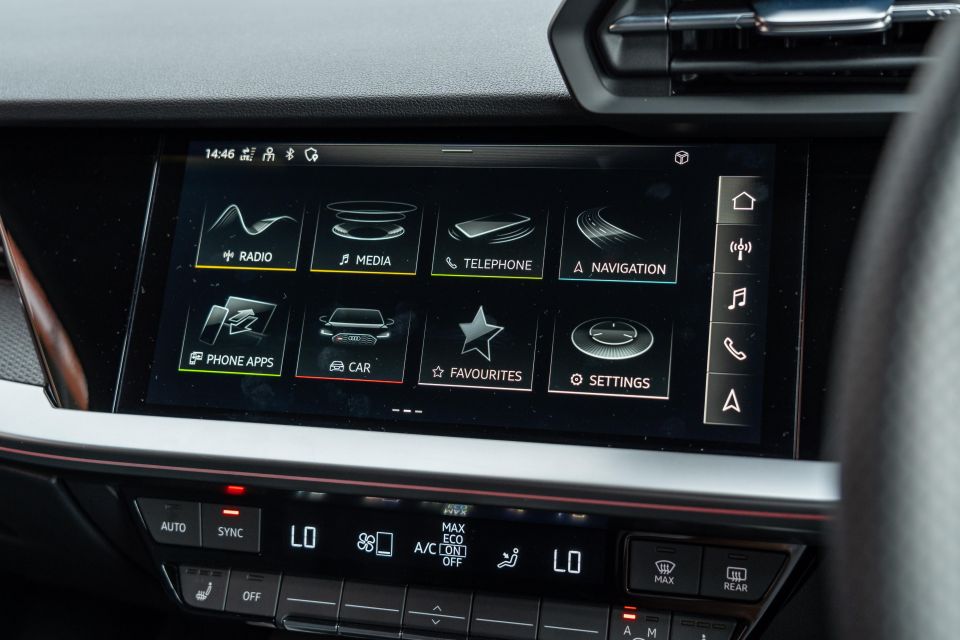
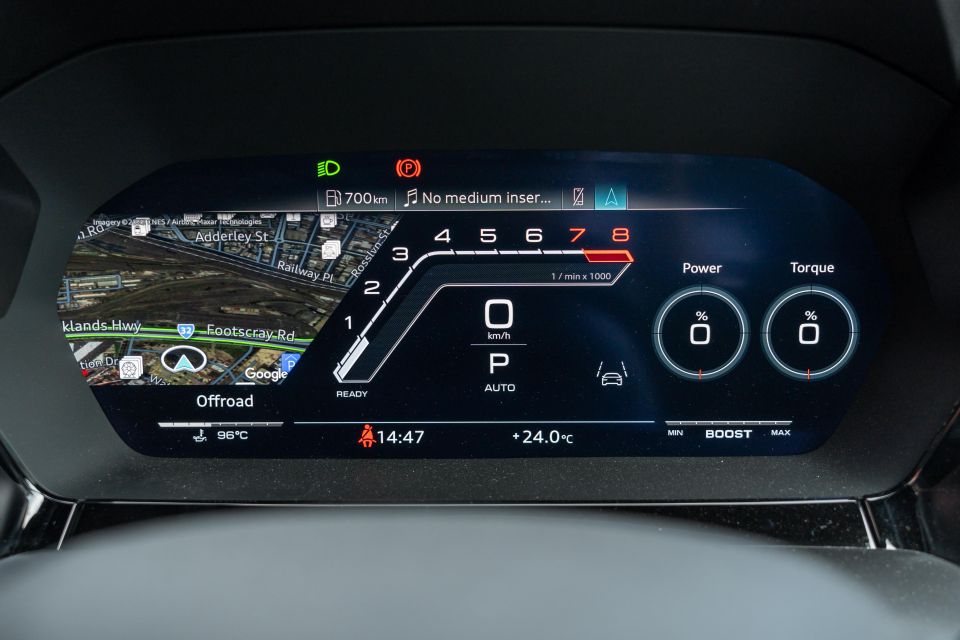

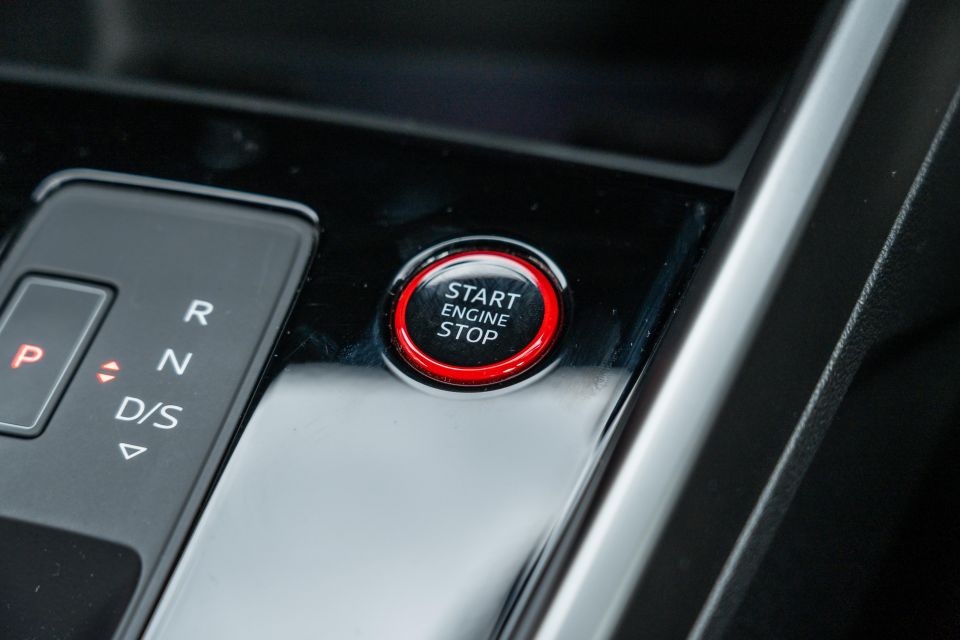
Below the touchscreen is a climate control pod with buttons (good), but none of the satisfying knurled dials that made the last A3 feel like a quality item (bad). I also miss the days of Audi screens retracting into the dashboard.
Facing the driver is a class-leading digital dashboard, complete with a range of RS-specific graphics. It offers more customisation than the Mercedes-AMG, packs in just as much usable information, and is easier to read at a glance.
Storage space is solid up front. The cupholders are in an open bin that can be toggled to hold two coffees, or opened up to store a phone, and there’s a wireless phone charger at the base of the dashboard.

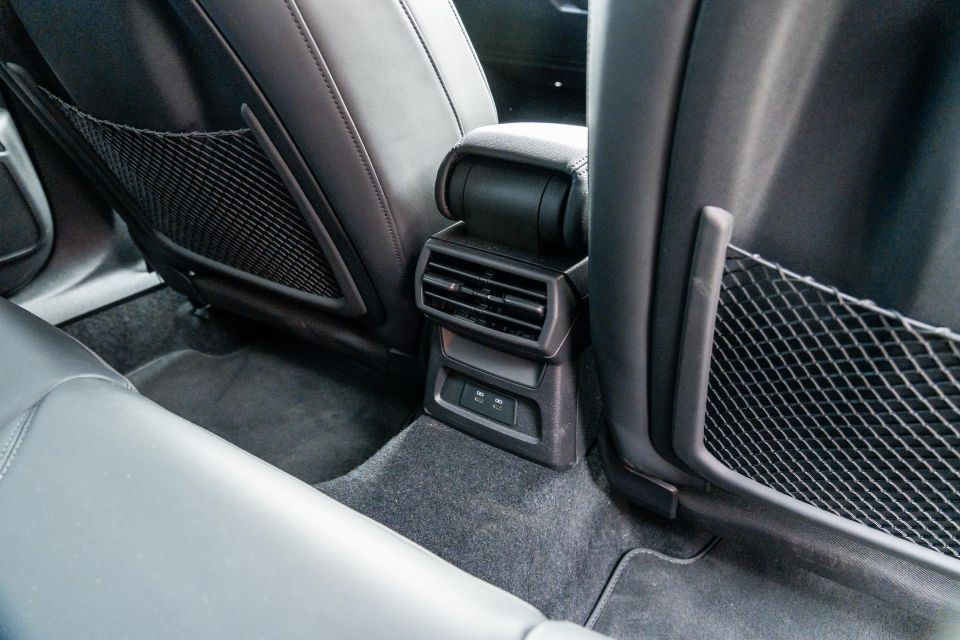
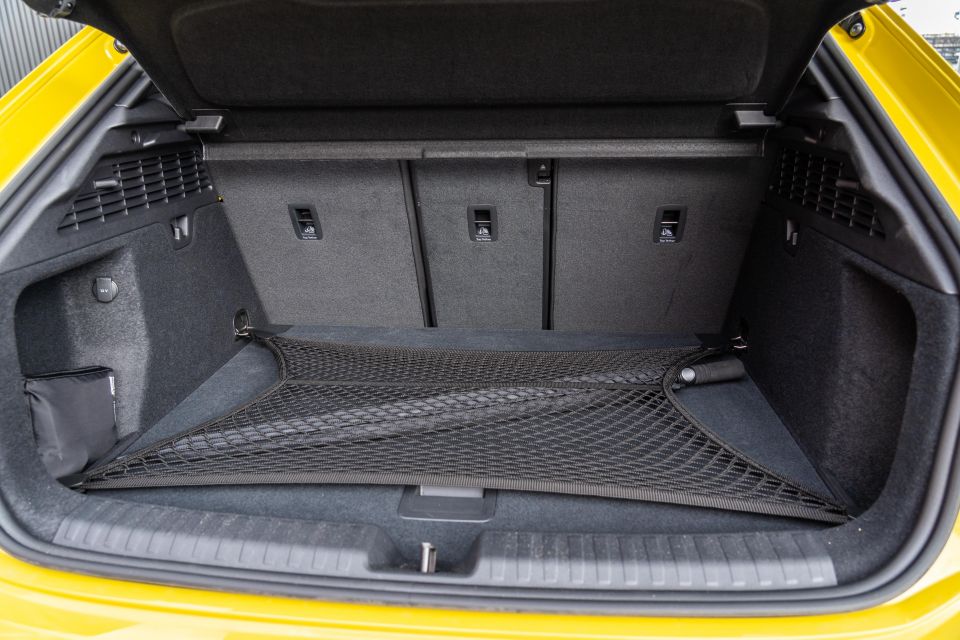

Rear seat space isn’t too dissimilar to the A45, but legroom and headroom are both slightly better. The view forward is better, and the bench itself is more comfortable. Like the AMG, the Audi features two USB-C ports back there, along with vents and a fold-down central armrest.
Boot space is a weak spot for the RS3. It has less than the regular A3 range because of the all-wheel drive hardware beneath the boot floor, something that doesn’t seem to afflict the more spacious A45 S.
You’ll need to fold the seats down to fit a golf bag, and getting in four people’s worth of weekend luggage will be a squeeze.
| AMG A45 S | Audi RS3 | |
|---|---|---|
| Length | 4445mm | 4389mm |
| Width | 1850mm | 1984mm |
| Height | 1403mm | 1442mm |
| Wheelbase | 2729mm | 2629mm |
| Track (front/rear) | 1597/1597mm | 1592/1524mm |
| Boot space | 370/1210L | 282/1104L |
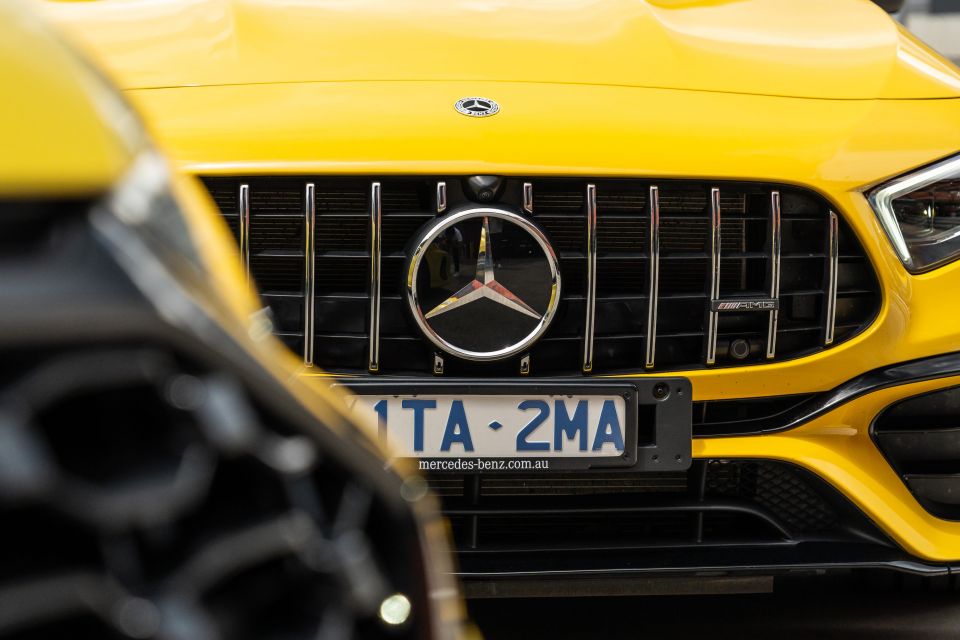

Where expert car reviews meet expert car buying – CarExpert gives you trusted advice, personalised service and real savings on your next new car.
Mercedes-AMG A45 S
Power in the smallest AMG comes from a pretty remarkable turbocharged four-cylinder petrol engine.
It displaces just 2.0 litres, but pumps out a whopping 310kW of power and 500Nm of torque. It’s mated to an eight-speed dual-clutch transmission, and is all-wheel drive as standard.
That undersells how sophisticated the powertrain in the A45 S really is, though. The turbocharger is good for up to 2.1 bar of boost, and features an electronic waste-gate instead of a pneumatic setup to more precisely control how boost builds.

The engine has been rotated 180 degrees relative to the outgoing car, sitting the turbo at the rear of the engine to reduce the amount of plumbing required and increase efficiency.
Matched with the engine is an all-wheel drive system capable of sending up to 100 per cent of the engine’s torque to the rear axle and, when it’s doing so, can use a limited-slip differential and two multi-plate clutches to deliver proper torque vectoring.
Check out the table at the end of this section to see claimed and real-world fuel consumption figures, acceleration figures, and braking figures.
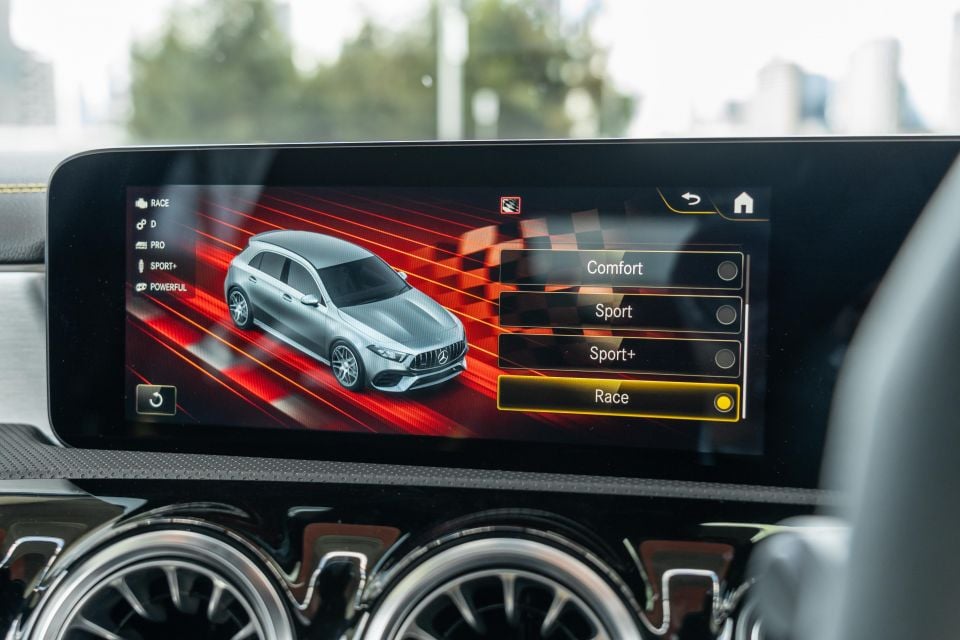
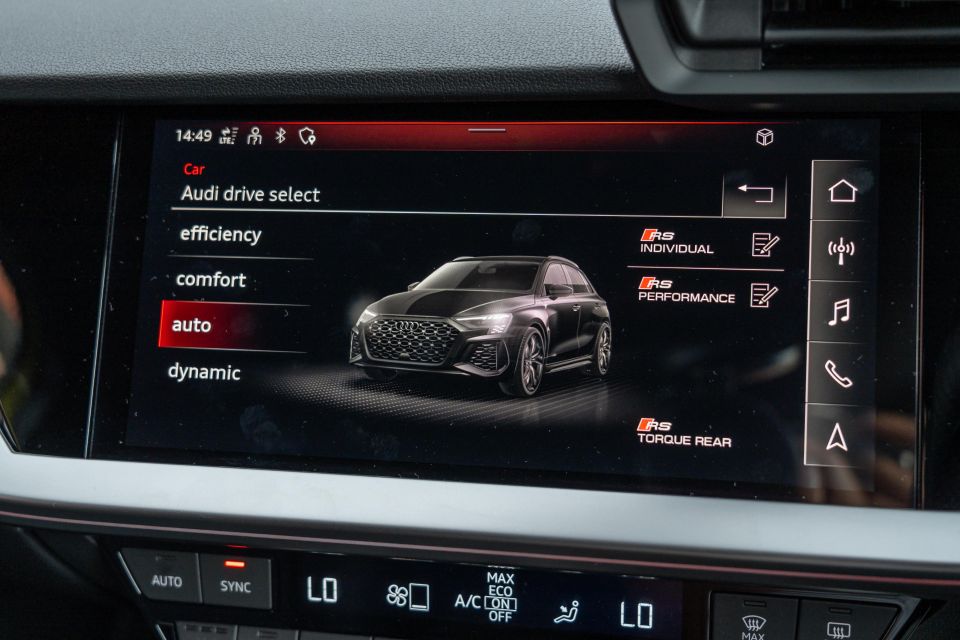
Audi RS3
The new RS3 bucks the trend for downsizing by sticking with its 2.5-litre turbocharged five-cylinder engine.
It makes 294kW of power and 500Nm of torque, and is mated to a seven-speed dual-clutch transmission and all-wheel drive as standard.
Audi has ditched the Haldex all-wheel drive system from the last RS3 for a more sophisticated quattro system dubbed RS Torque Splitter. Although it’s still front biased by default, it now packs a few tricks that were previously off-limits.
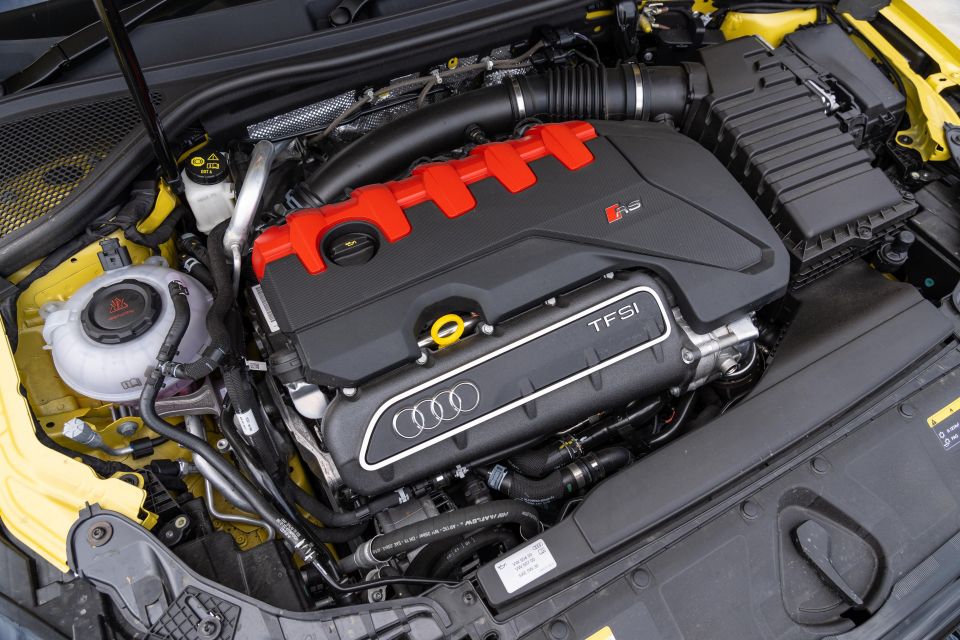
Up to 100 per cent of torque can be sent to the rear axle, where the torque splitter unit uses a pair of electronically-controlled clutches to apportion that torque to a particular wheel for proper torque vectoring, and drift mode – or the infinitely less evocative Torque Rear mode, as Audi calls it.
Check out the table at the end of this section to see claimed and real-world fuel consumption figures, acceleration figures, and braking figures.
| AMG A45 S | Audi RS3 | |
|---|---|---|
| Displacement | 2.0L, turbo | 2.5L, turbo |
| Cylinders | Four | Five |
| Power | 310kW | 294kW |
| Torque | 500Nm | 500Nm |
| Driven wheels | All | All |
| 0-100km/h (claim) | 3.9s | 3.8s |
| 0-60km/h (tested) | 2.0s | 1.9s |
| 0-100km/h (tested) | 4.0s | 3.8s |
| 80-120km/h (tested) | 2.4s | 2.4s |
| 100km/h-0 (tested) | 37.4m @ 1.1g | 37.3m @ 1.1g |
| Economy (combined claim) | 8.9L/100km | 8.8L/100km |
| Economy (highway tested) | 7.7L/100km | 7.5L/100km |
| Fuel tank | 51L (98 RON) | 55L (98 RON) |
| Kerb weight | 1635kg | 1570kg |
All tests were conducted by the same driver, in the same conditions. Acceleration times were collected by putting the car in its most aggressive drive mode and using launch control on an unprepared surface.
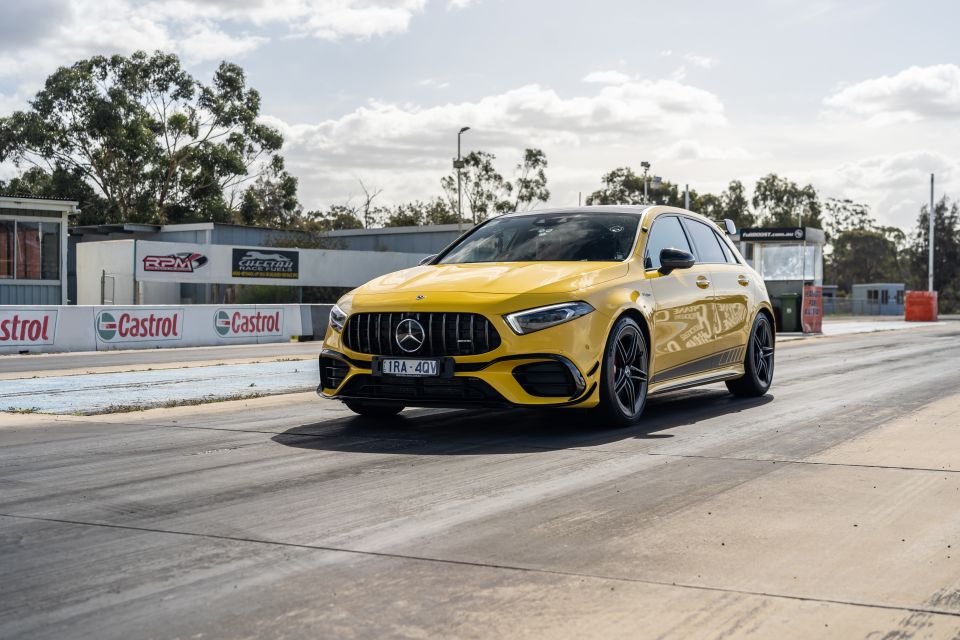
Launching these cars is a physical experience.
The process in both is similar: flick into the raciest drive mode, press the brake firmly, bury the accelerator, wait for the computer to confirm Launch Control is ready… then release the brake, and hang on tight.
We were blown away by the A45 S when it debuted in 2020, and it’s still impressive as it approaches its mid-life update. Each of its 100km/h sprint times was within a tenth, and getting it off the line is idiot proof.
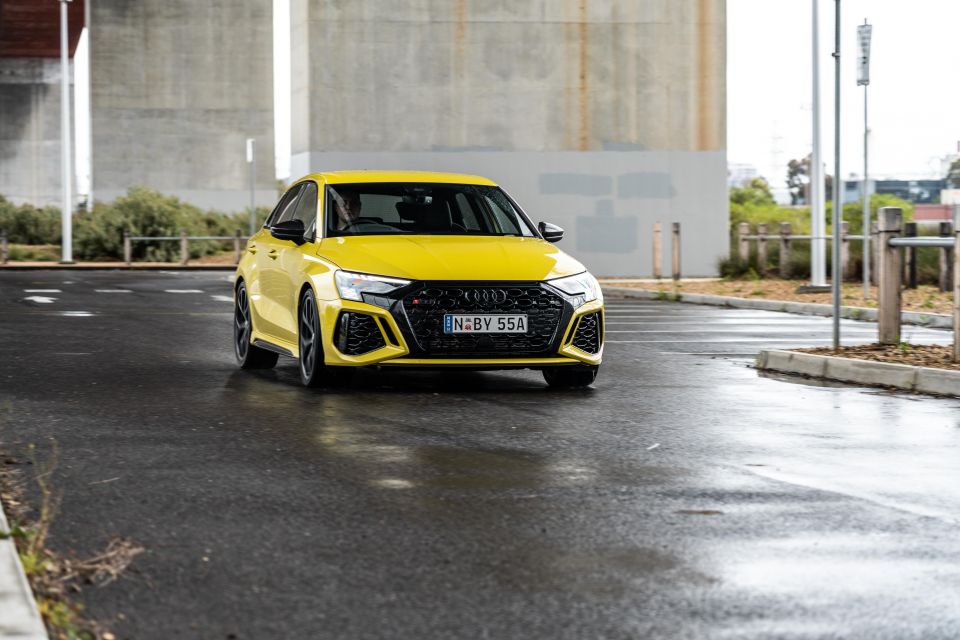
Arguably more impressive is the fact the less powerful Audi had its measure, and managed to repeatedly match its manufacturer claim on a less-than-perfect surface.
Its five-cylinder sounds distinctly rally-ish as it grinds against the limiter, but there’s less fanfare or fireworks than in the AMG. Step off the brake and it just hooks up and goes, with what feels like maybe a hint more clutch slip than you get in the A45 S.
Of course, actually driving these things is about more than performance figures.
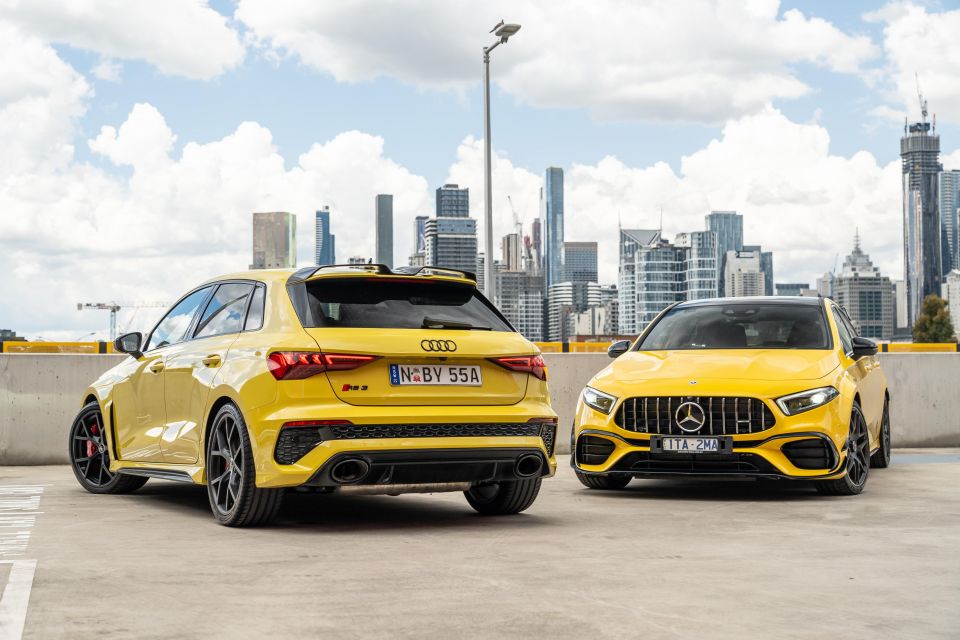
There’s a sense of purpose to everything the A45 S does.
No matter which of its five drive modes you’re in, there’s no getting away from the fact this is a serious little hatch. It fires with a bark, and even in Comfort has direct steering and tight body control that speak to its intent.
That’s not to say it isn’t comfortable on the daily grind; the fact Mercedes-AMG has managed to make such a small engine running so much boost drivable in traffic, and has managed to dial some compliance into a city hatch riding on 19-inch wheels wrapped in 245/35 tyres, is deeply impressive.
The Audi is better again, though. Where the AMG has what feels like a thin veil of compliance built in for around-town driving, the RS3 actually isolates you from the outside world around town. It still feels tautly sprung, but it’s able to breathe over bumps that upset the A45.
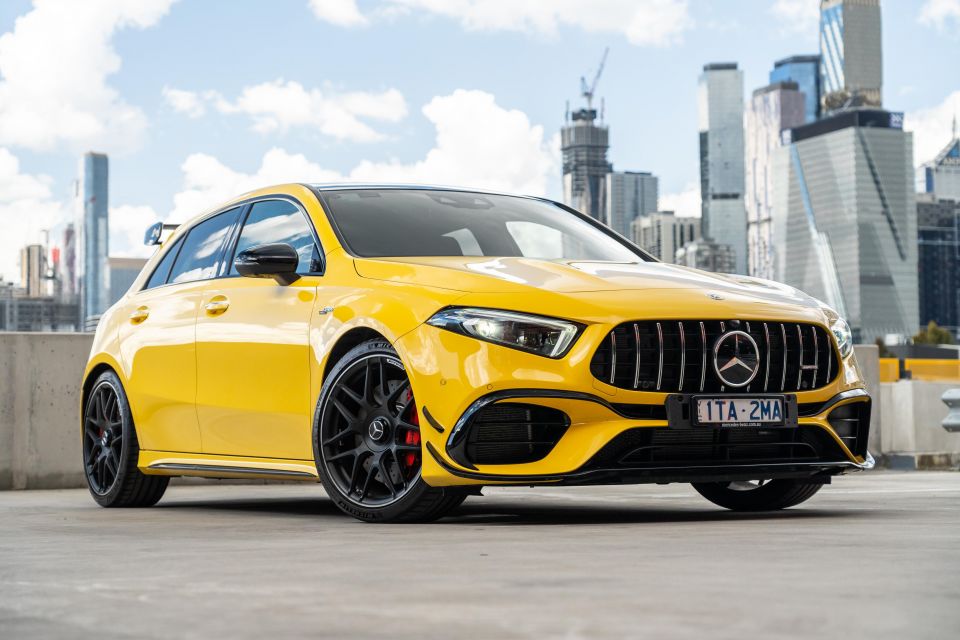
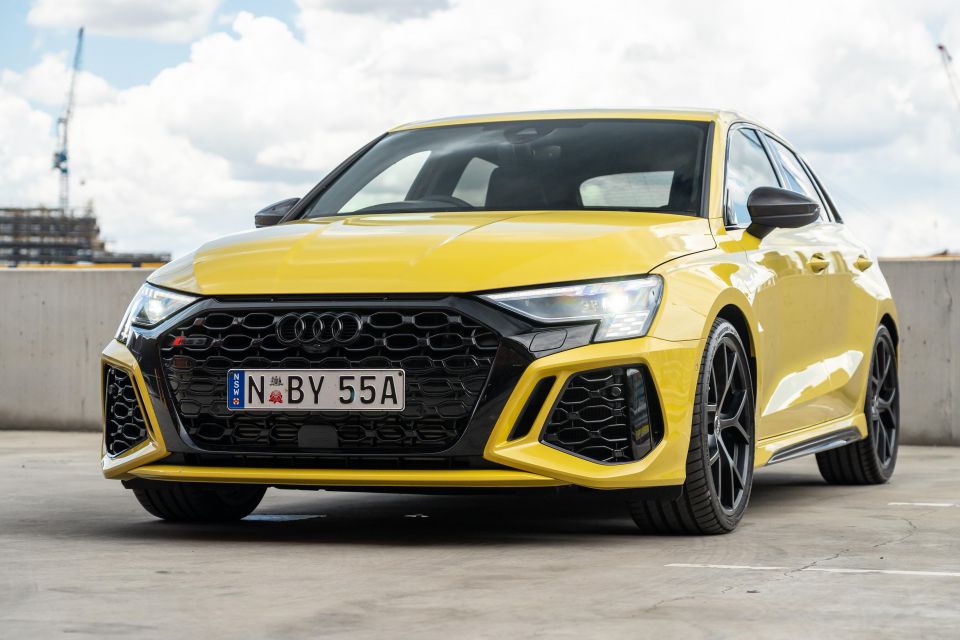
Its steering is lighter, and the seats are more generously padded, which also play a role in making the Audi feel more at home in town. Where it struggles is when it comes to manoeuvrability.
With a wider front track, bigger wheels, and wider tyres than a standard A3 up front, there’s clearly not much room in the front wheel arches. That means you haveless lock to play with in tight spaces than in the A45, as evidenced by the 12m turning circle – the A45 S has a better 11.54m turning circle.
You need to think carefully about reverse parks or tight u-turns in both, but it’s much more noticeable in the Audi.
Save for a slightly hesitant dual-clutch transmission between standstill and second gear, and the occasional moment of laziness from the engine if you catch it off-boost, the A45 S is almost as easy to drive as an A250.
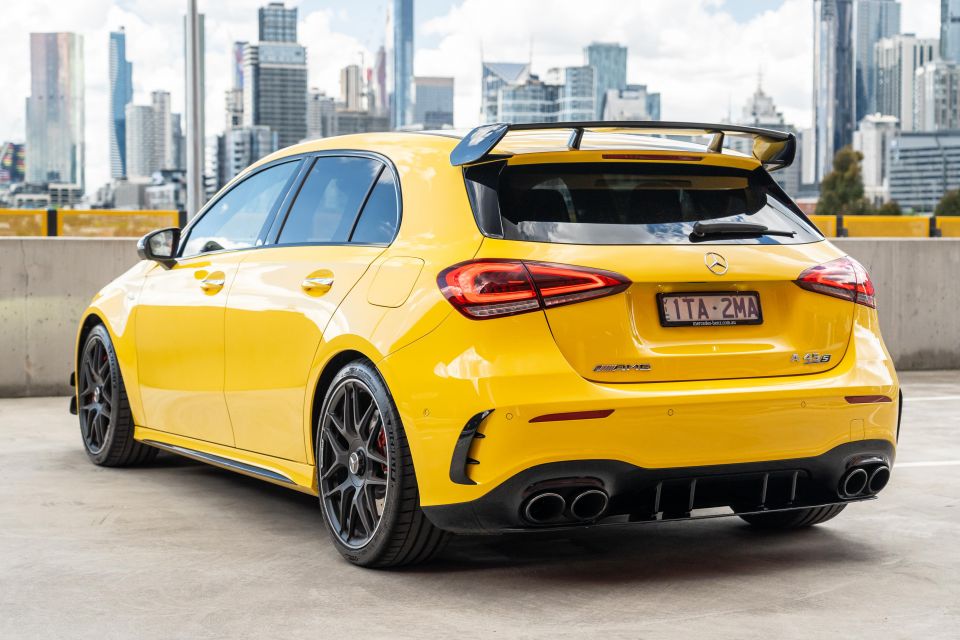
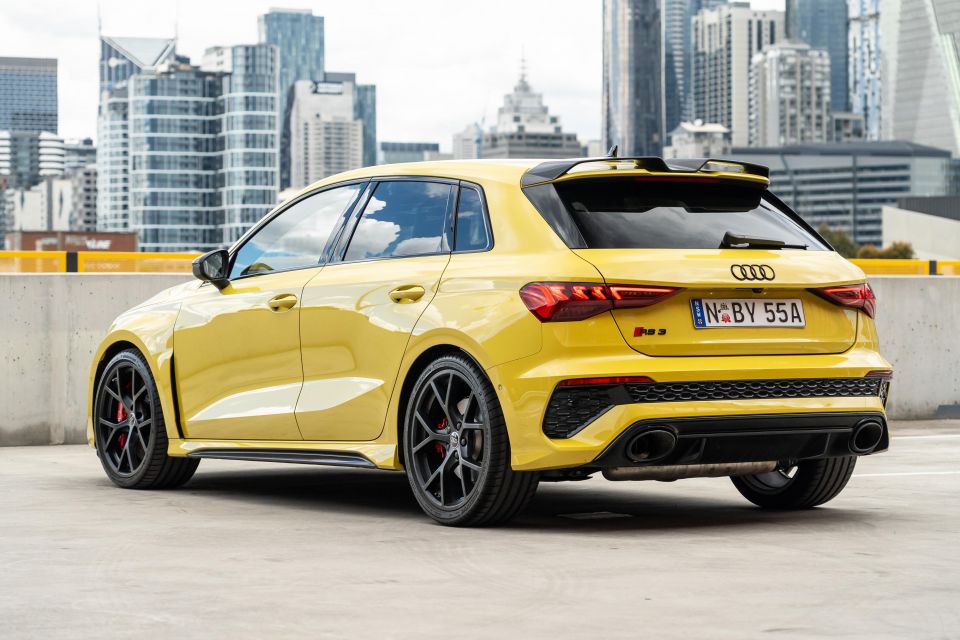
You won’t mistake it for an A250 when you put your foot down. The way it delivers its performance is intoxicating, starting with a surge of torque from down low and building in intensity through to the 6750rpm power peak, and the 7000rpm redline.
Some turbocharged engines can feel a bit one-paced, surfing a chunky wave of torque in the mid-range but never changing in character. That isn’t the case in the A45, which rewards you for exploring the upper reaches of the rev range.
It sounds a bit anodyne alongside the bombastic RS3, though. With the exhaust in its default it has a flat bark, and flicking into Powerful adds a bit more bass to the mix, but it’s purposeful rather than charming like the Audi.
Even though it’s been gagged by a particulate filter and strict European drive-by noise restrictions, the RS3 makes a noise unlike any other in the motoring world. It gurgles and gargles on light throttle, and in Dynamic the metallic bark it makes at full throttle calls to mind classic rally cars.
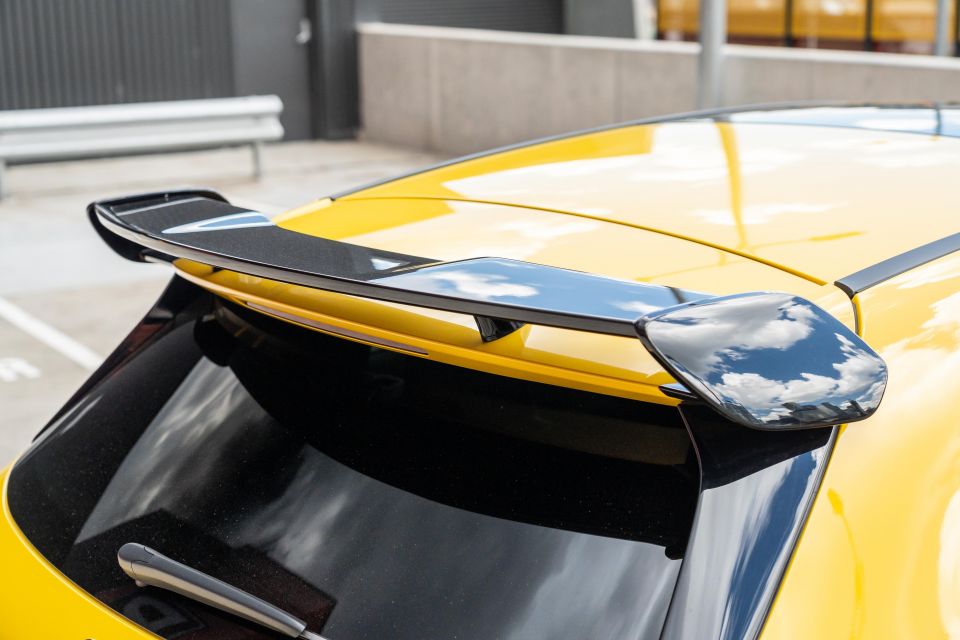

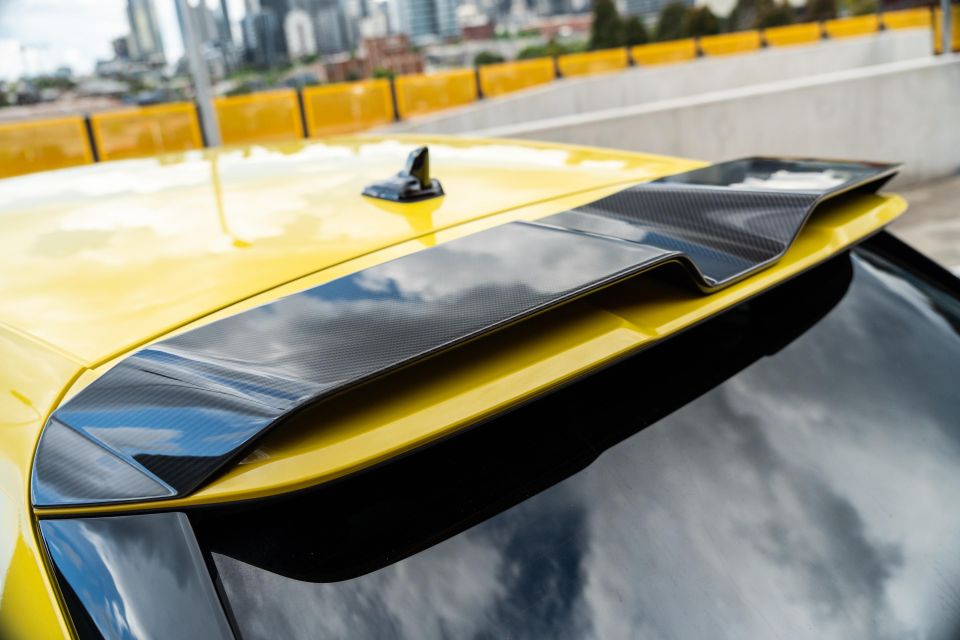
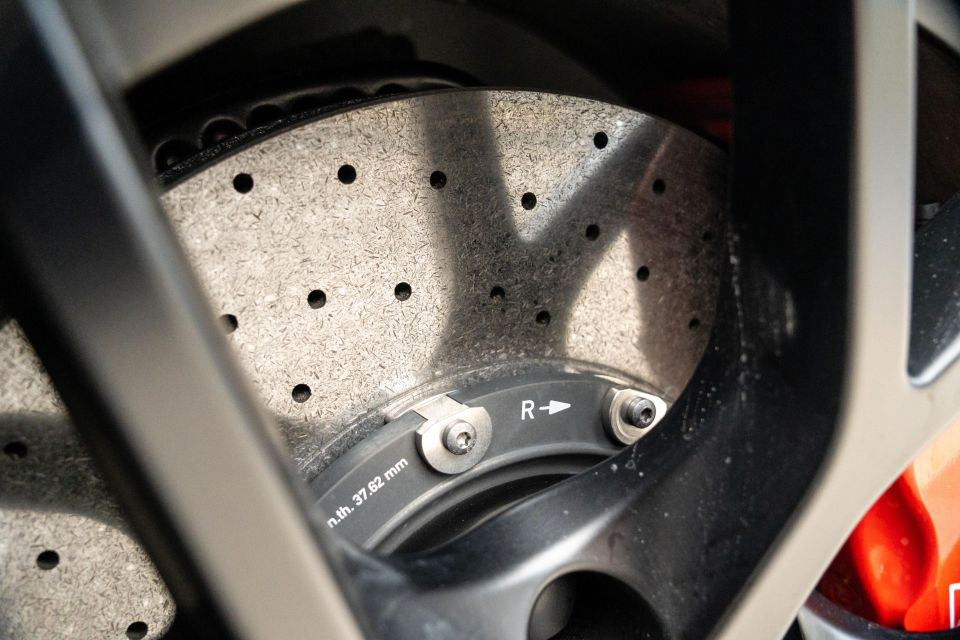
We’d be heading straight to a tuner and seeing what could be done to free up even more noise…
While we’re talking noise, the amount of road noise in the cabin at highway speeds is hilariously bad in both cars. To our ears the Audi is marginally worse, but both will have you cranking up the stereo to drown out the drone away from perfect surfaces.
Relative to the AMG, the Audi is a bit more laid-back in how it delivers its performance. The transmission isn’t as snappy at city speeds, and the extra displacement means you can rely on it to pull from lower engine speeds without kicking down.
It pulls every bit as hard when you bury the throttle, ripping to its 7000rpm redline. It doesn’t quite build in intensity like the AMG, but it doesn’t run out of puff either.
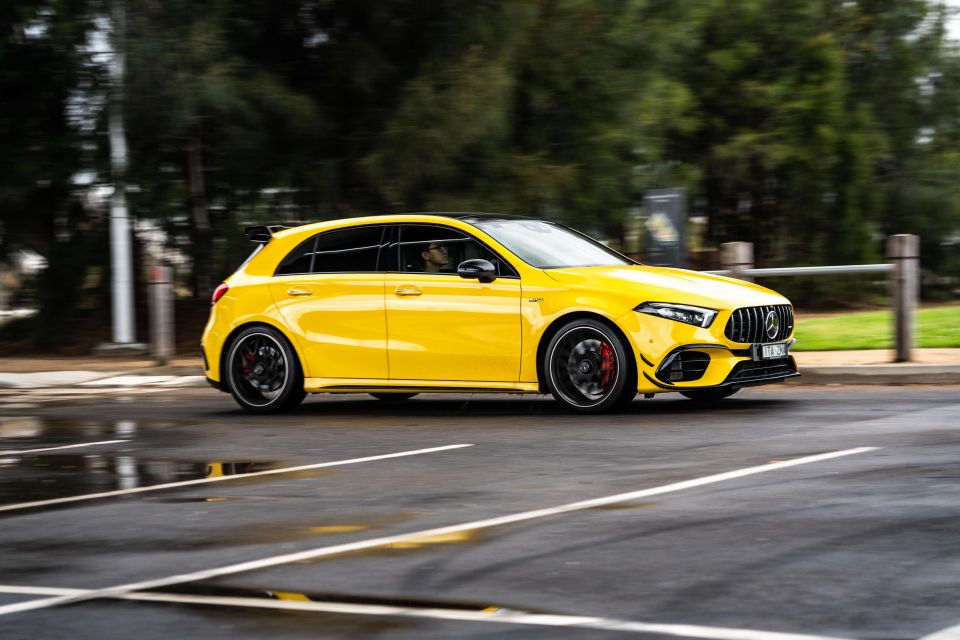
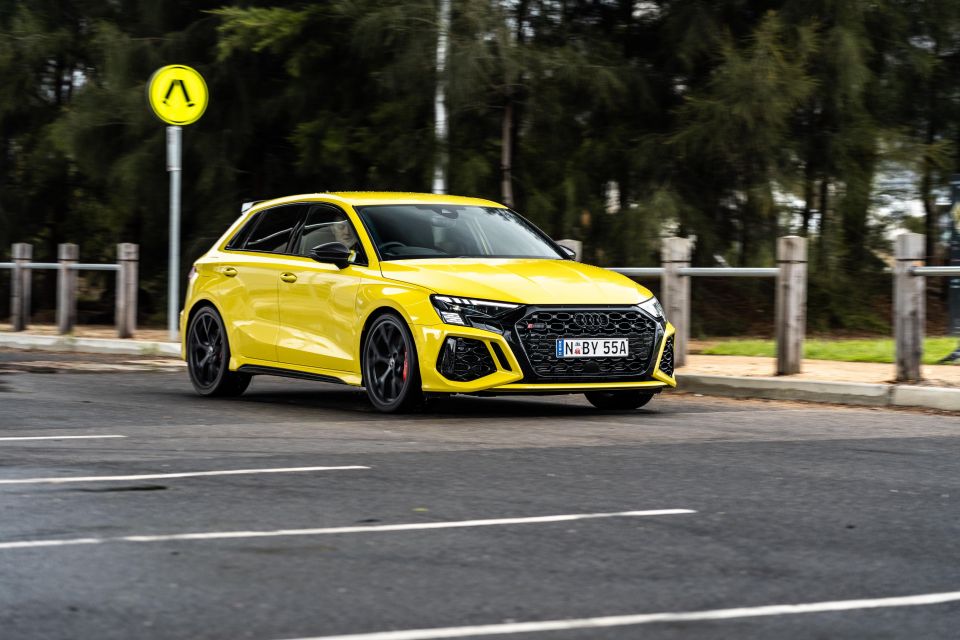
Audi has been criticised for developing one-dimensional driver’s cars, but it’s dug deep into its bag of tricks to bring the RS3 to life. It’s worked, because this is far from a one-trick pony now.
The wider front track breeds confidence the nose will go where you want it to on corner entry, and in RS Performance mode you can really feel the clever all-wheel drive system working to rotate the car when you get on the power.
Rather than ugly understeer, you can feel the Audi’s computer brain shooting power to the outside rear wheel as you feed in the throttle mid-corner. It feels more aggressive in the way it moves grunt around relative to the AMG, to the point where it almost feels like you have rear-steer at times.
It’s livelier than its German rival when you’re on the power, and the more muscular mid-range means you’re less likely to catch the engine off the boil on corner exit. The Mercedes-AMG still feels like the more serious car of the two.
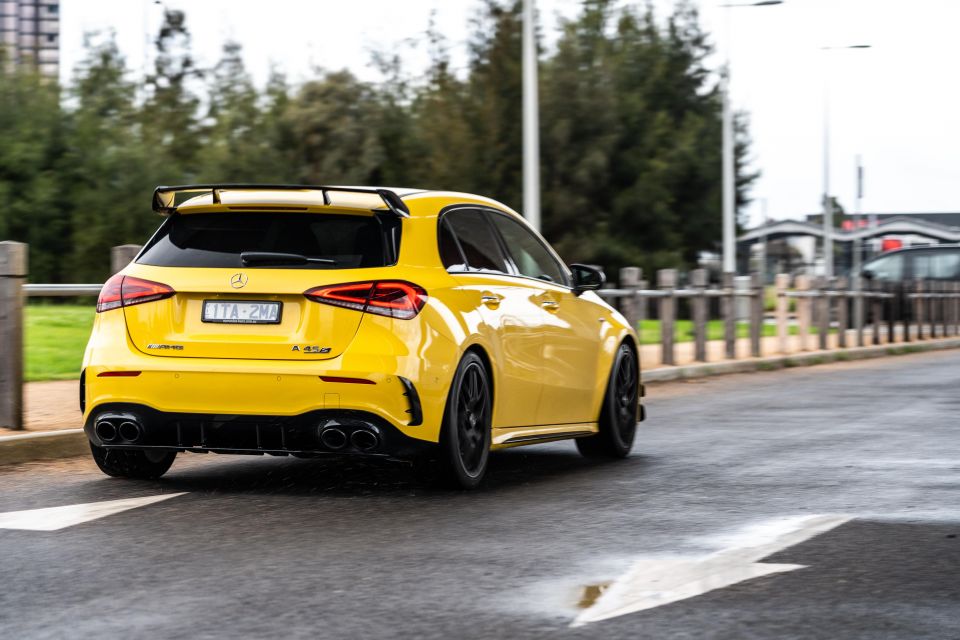
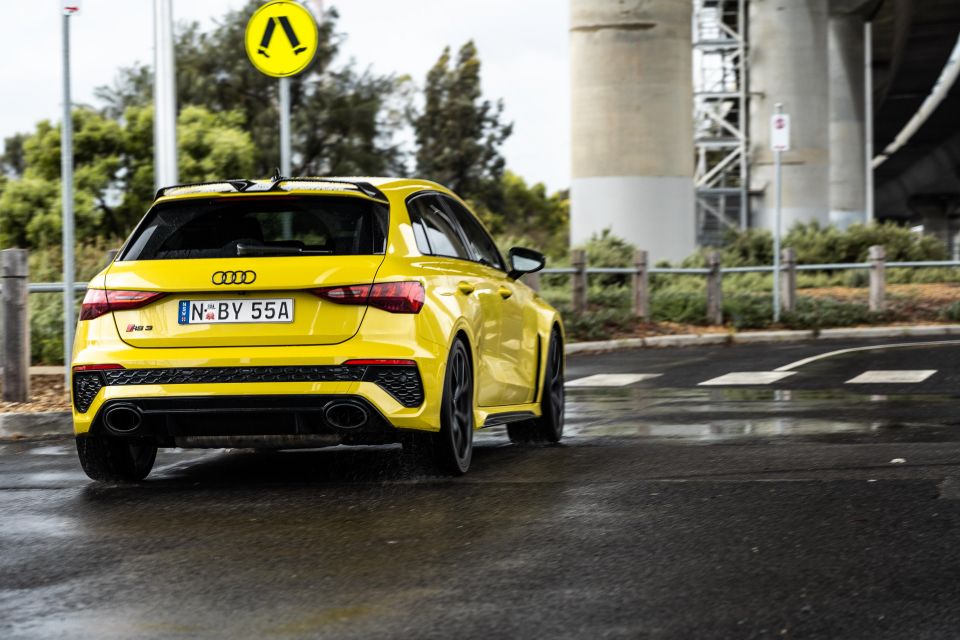
The extra compliance and daily drivability built into the RS3 means it feels a bit wooly at times. The steering lacks the clarity of the A45, even in its raciest mode, and the amount of torque shuffling going on means it doesn’t always react the same way to similar inputs.
There’s a hint of slack at the top of the brake pedal, and the throttle isn’t as sharp. The RS3 is loud and playful; the Mercedes-AMG means business.
With five drive modes, and the ability to fiddle with the suspension, transmission, ESP, and exhaust within each of those modes, it can take a while to dial in the right setup – but once it’s set up, it makes the Audi feel tame.
On our Lang Lang handling loop we had the powertrain in Sport+, the suspension in the middle of its three setting, the transmission in manual, the dynamic assists in their most lenient Pro setup, and the exhaust in loud.

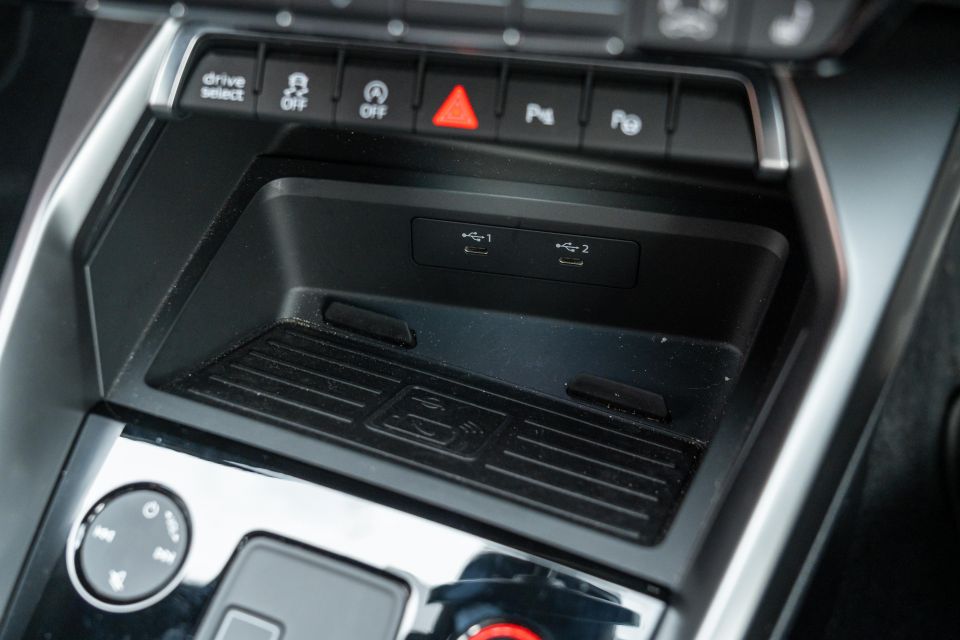
Although it isn’t quite as keen to get you edging sideways on corner exit, the AMG A45 S has the more playful chassis of the two cars under brakes. The ESP allows you to get it rotating gently on corner entry in AMG Pro mode by trail braking, at which point the crisp, slightly heavier steering allows you to place the car more confidently.
Traction is immense from the Michelin Pilot Sport 4S tyres, and the four-wheel drive system claws you out of corners determinedly, at which point the bassy exhaust, more brutal upshifts, and peakier engine make the whole thing feel like a wannabe racer.
It’s the pick of the pair for anyone who wants to systematically pick apart a circuit, but you need to be willing to make some sacrifices for that ability.
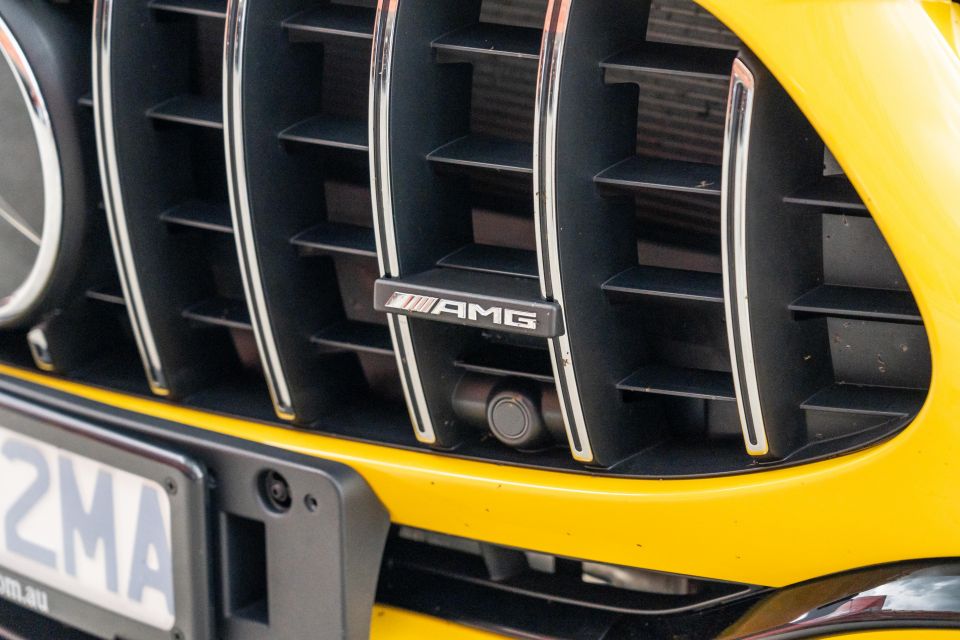
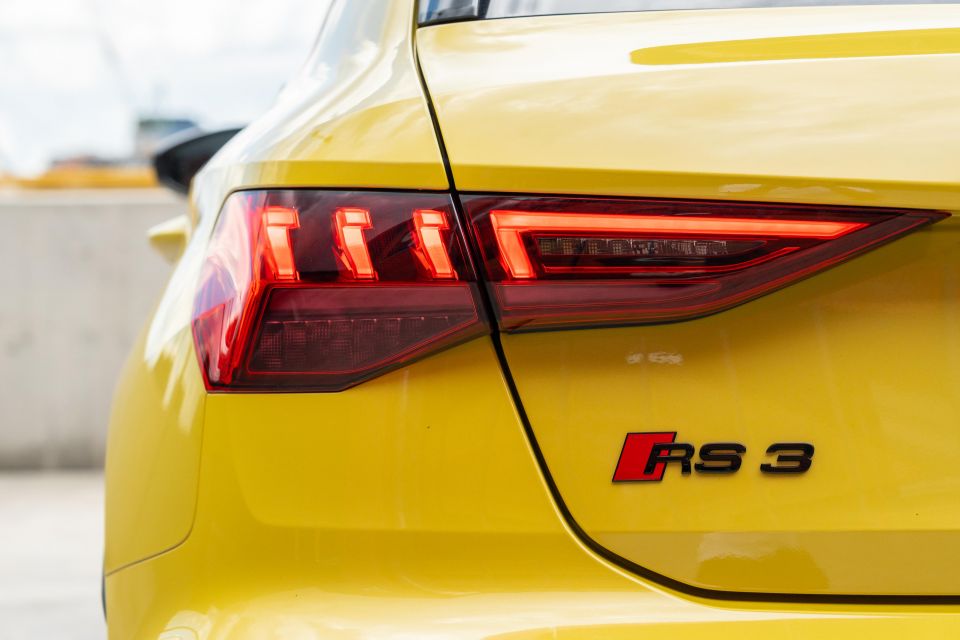
Mercedes-AMG A45 S
Mercedes-Benz Australia offers a five-year, unlimited-kilometre warranty across its range.
Maintenance in the A45 S is required every 12 months or 20,000 kilometres, whichever comes first.
Three years of maintenance will set you back $3600, four will cost $4450, and five is priced at $5150 using a prepaid service plan.
Audi RS3
Audi Australia offers a five-year, unlimited-kilometre warranty across its range.
Maintenance in the RS3 is required every 12 months or 15,000 kilometres, whichever comes first.
Audi offers five-year service pack for $3580 if you pay upfront, with two-year extensions available for purchase from there.

Who needs a supercar? Although around $100k isn’t exactly cheap, it’s pretty damn affordable when you consider both these cars will hit 100km/h in four seconds regardless of who’s behind the wheel.
They have their prodigious performance in common, but don’t be fooled into thinking the RS3 and A45 S are alike.
The AMG makes a bigger impression than the Audi. It’s more purposeful, which demands more compromise from the driver on the daily commute, but the pay-off is a pint-sized hatchback that will pick apart a winding road like few other cars on the road.
If your alarm clock is calibrated to the nearest one-thousandth of a second and your driveway has red-and-white kerbs, it’s unquestionably the pick of this pair.
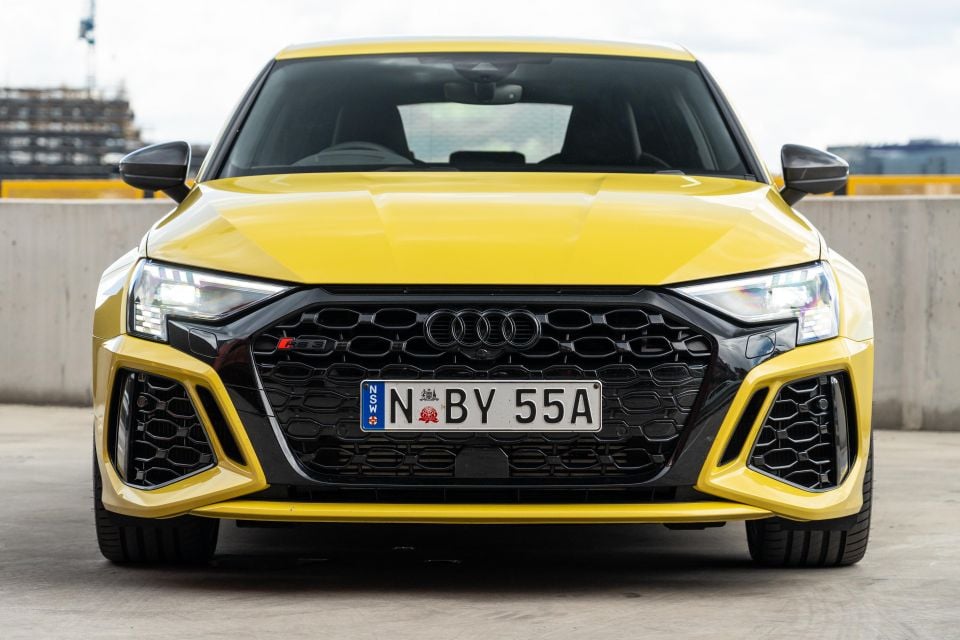
Hot hatches are about more than lap times, though. By eschewing the focus of the engineers in Affalterbach, the Audi Sport team in Ingolstadt have created a car that’s easier to enjoy, more of the time.
The characterful five-cylinder engine and the plush and intuitive interior are Audi RS staples at this point; the fact it now feels alive when you take it by the scruff of the neck rounds out the package.
Steer clear of the carbon ceramic brakes, though. The options package undermines the value equation, and isn’t really in keeping with the car’s pitch as a more rounded, less track-oriented package.
It’s narrowly the winner of this comparison, and the car I’d buy given the choice.
MORE: Everything Audi RS3 MORE: Everything Mercedes-AMG A45
Share your thoughts with us in the comments below!
Scott Collie is an automotive journalist based in Melbourne, Australia. Scott studied journalism at RMIT University and, after a lifelong obsession with everything automotive, started covering the car industry shortly afterwards. He has a passion for travel, and is an avid Melbourne Demons supporter.
Share your thoughts and write a review of a car you own and get featured on CarExpert.


Max Davies
1 Hour Ago


William Stopford
17 Hours Ago


Ben Zachariah
18 Hours Ago


Derek Fung
19 Hours Ago


Matt Campbell
1 Day Ago


William Stopford
2 Days Ago